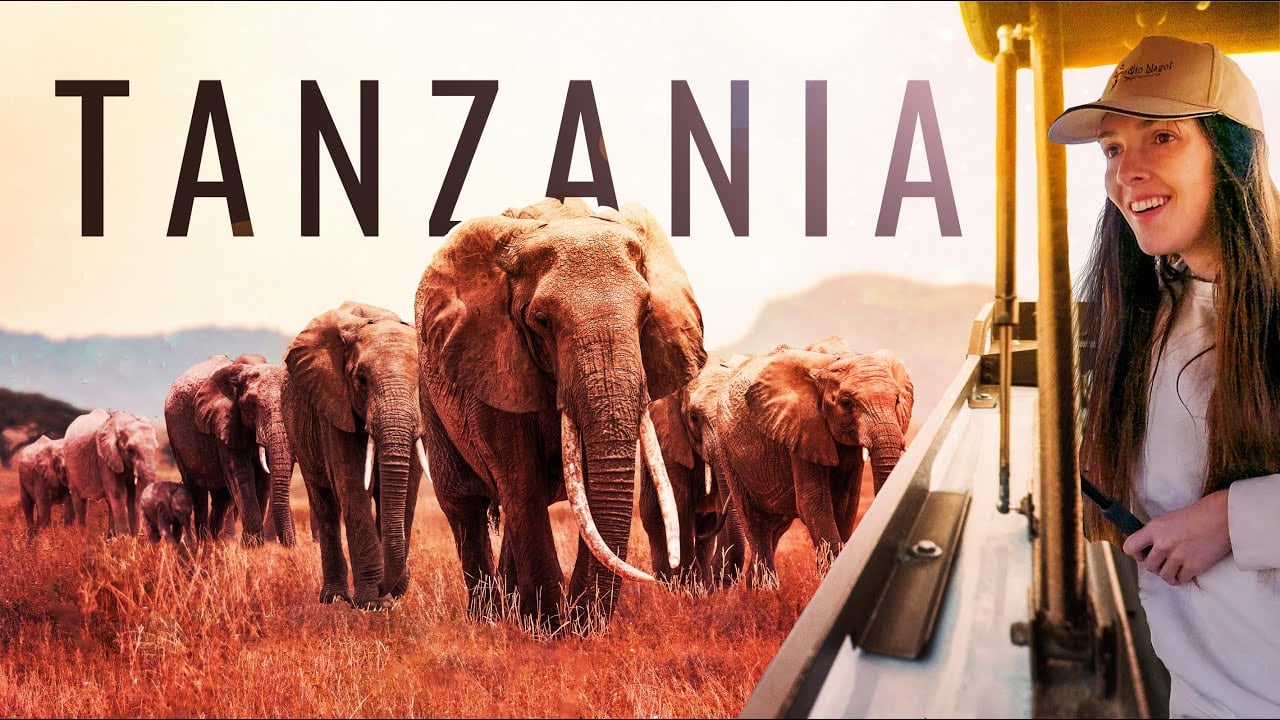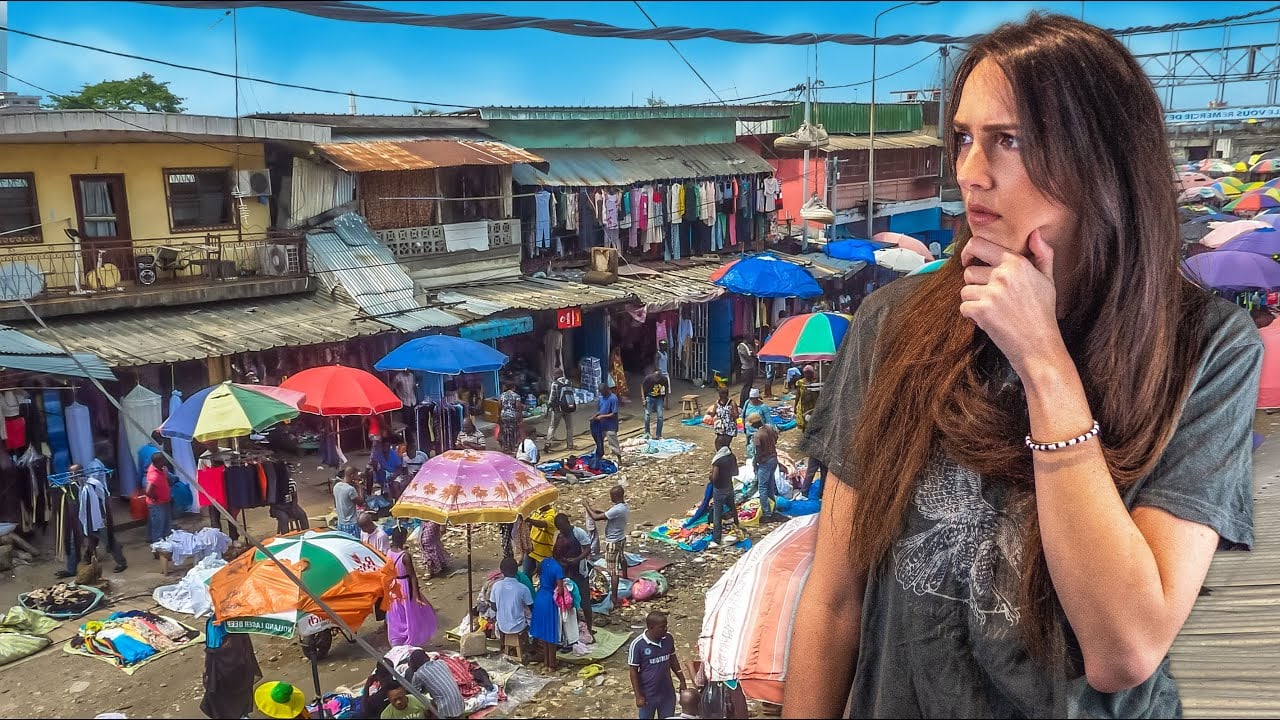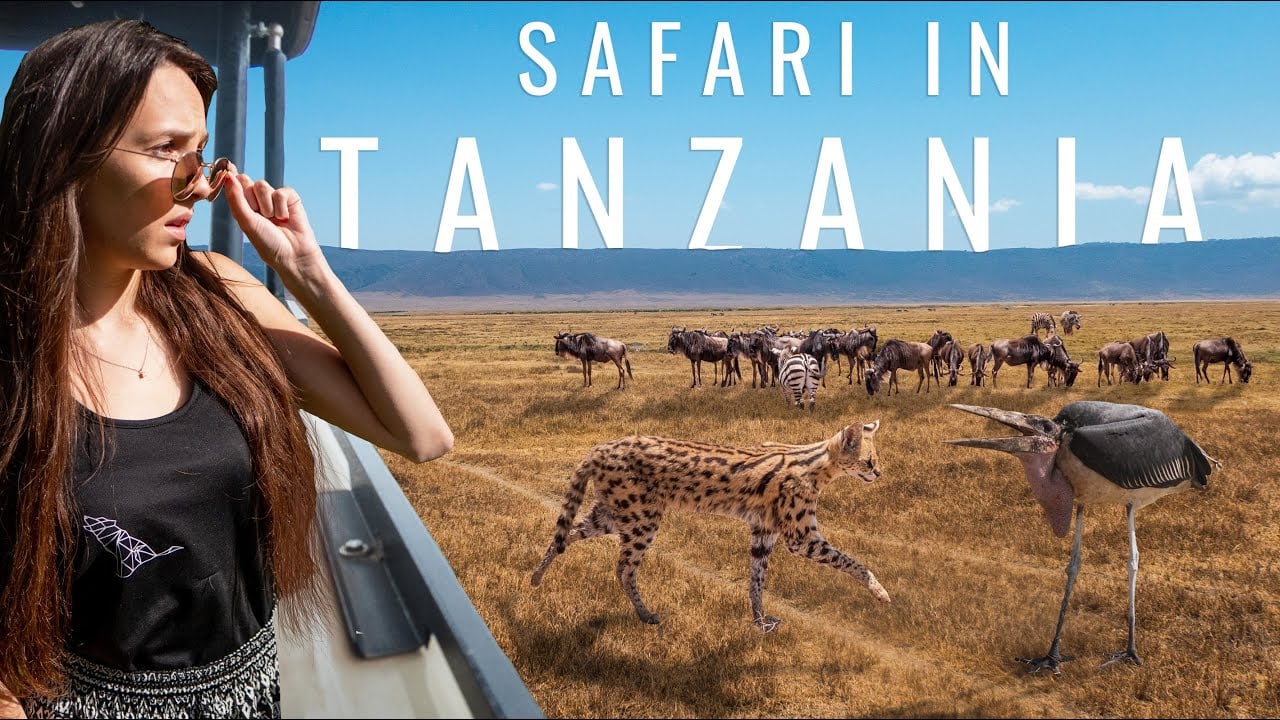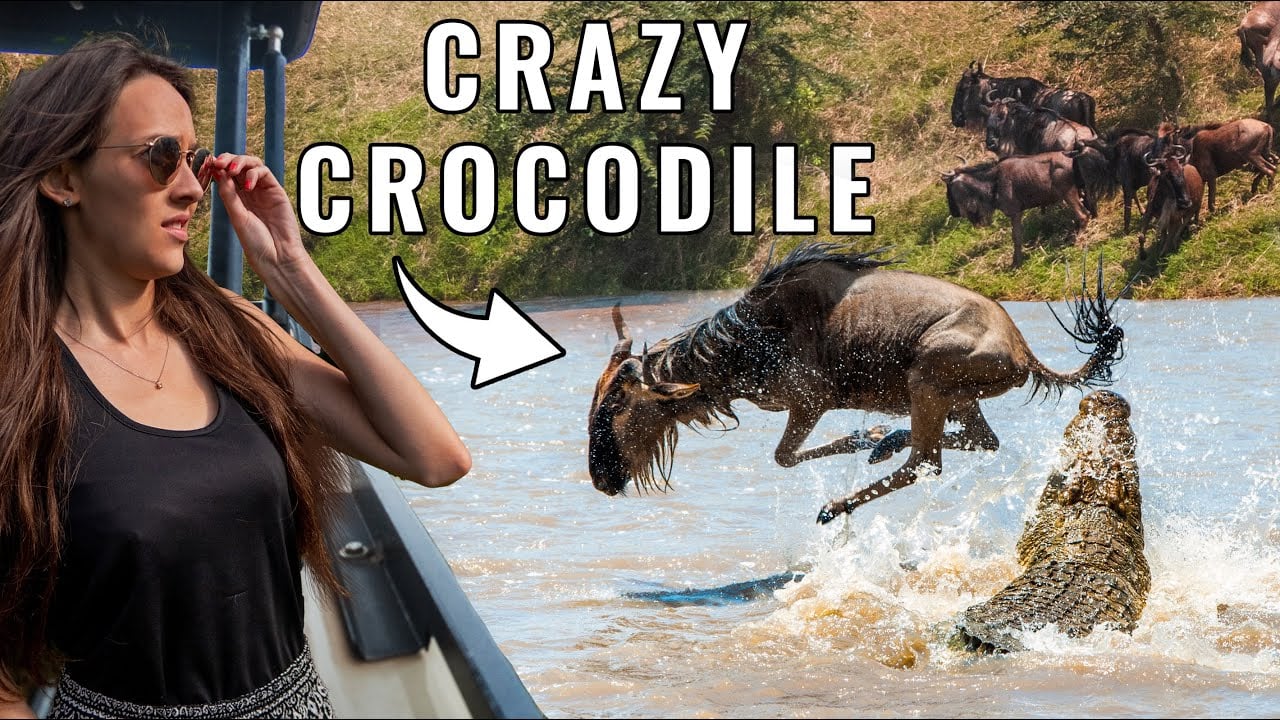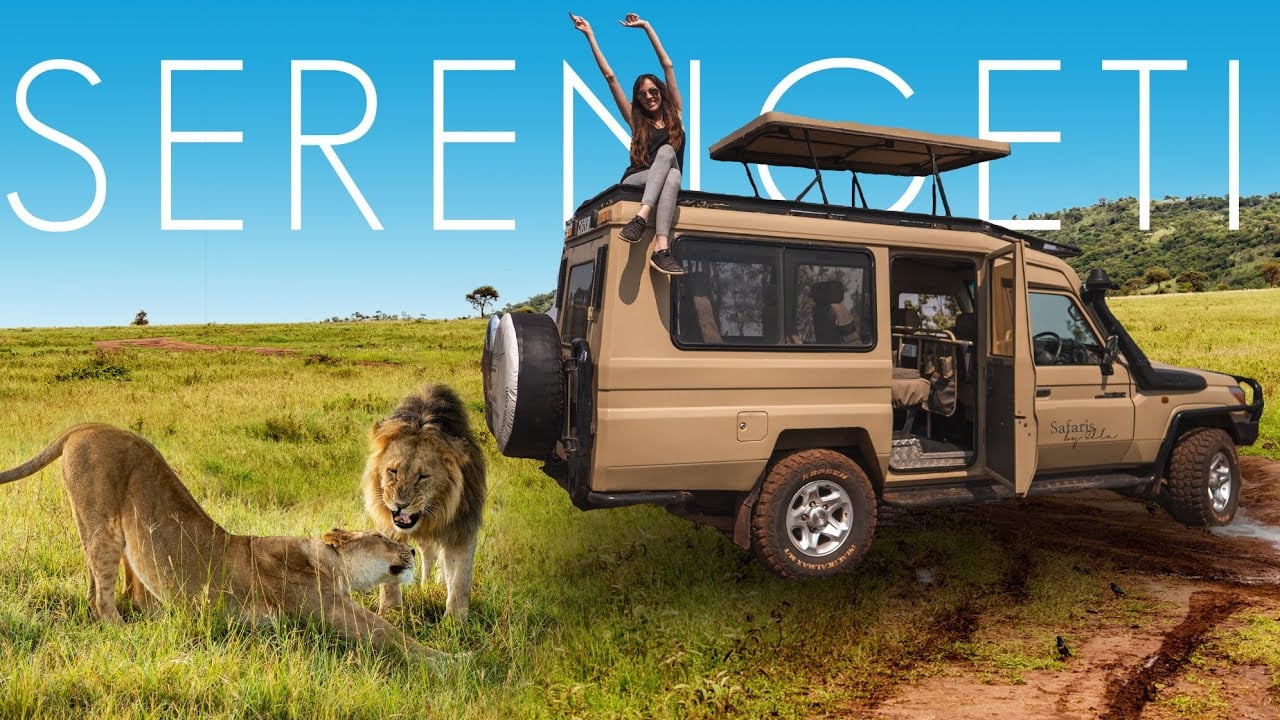From watching fluffy leopard cubs frolicking around in the Serengeti grasslands to gazing in wonder at the massive herds of majestic African elephants in Tarangire, my experiences in Tanzania have frequently taken my breath away.
If, like me, you love watching incredible animals in their natural habitats and visiting some of the most beautiful landscapes on earth, then I have no doubt that you’ll fall in love with Tanzania too.
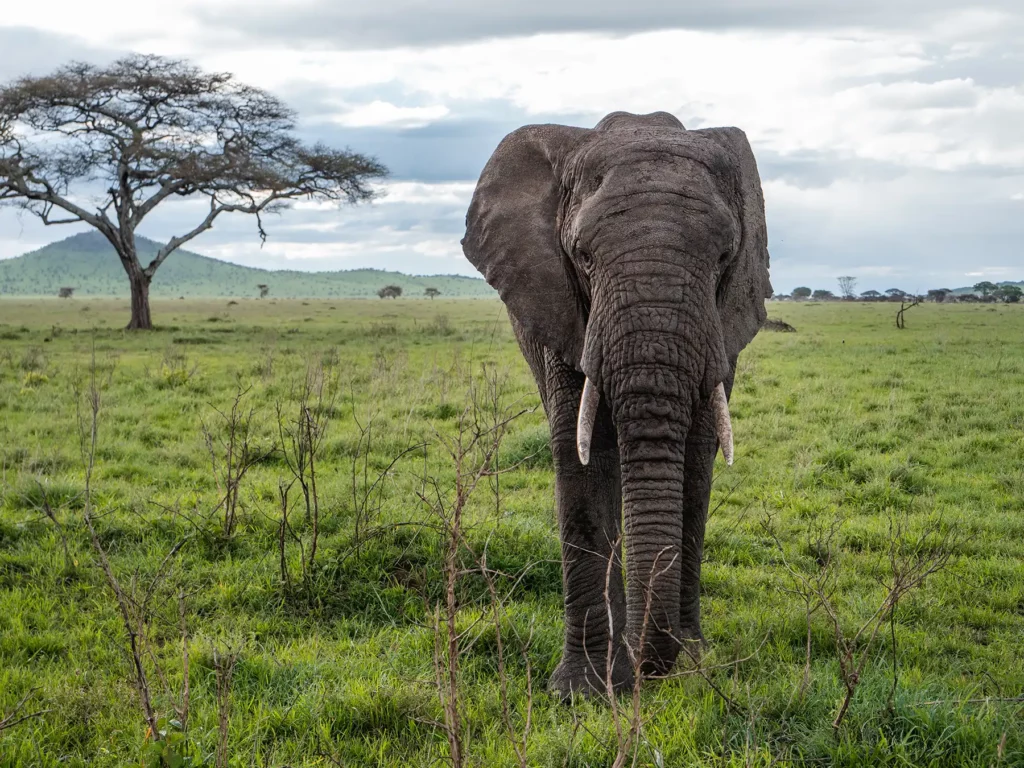
Boasting the world-class Serengeti National Park with its tree climbing lions, Tanzania is arguably the world’s ultimate safari destination.
The most popular safari route in Tanzania is called the Northern Circuit. This circuit includes the mystical Ngorongoro Crater, home to the rare black rhino and Tarangire National Park with its huge elephant herds.
In addition to the incredible national parks and wildlife, Tanzania is unique in its cultural diversity with over 120 tribes.
Each tribe has their own unique culture and traditions such as the famous Maasai Tribe with their iconic jumping dance and the Hadzabe bushmen who live as they did thousands of years ago and speak in a clicking dialect.
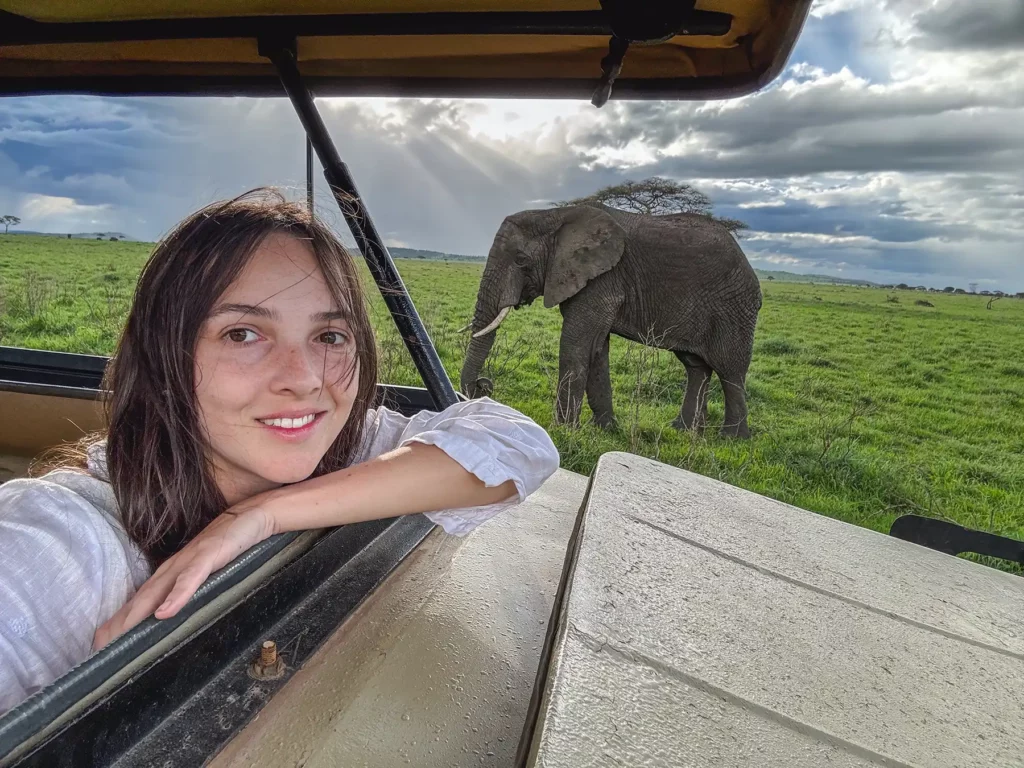
With so much to see you might be wondering if a 3-day Tanzania itinerary will cut it?
Yes – it’s certainly possible to have an incredible 3-day safari and this is actually a very popular option. However, If you have time, I would recommend adding a couple of extra days to give you a 5 day Tanzania itinerary. If you’re not limited by time, you can easily fill out a 7-10 day safari itinerary too.
The main reasons a 3-day itinerary can work well in Tanzania are:
- The sheer density of wildlife (including predators) in the national parks gives you a good chance of some amazing sightings in a short period of time*.
- The high number of airstrips, which gives you the option to quickly fly to the various parts of the best national parks such as the Serengeti, which would otherwise be an 8 hour drive from Arusha.
- For travel by road there are some fantastic parks within easy driving distance of Arusha, which I’ve covered in my 3 Day Multi-Park Northern Circuit Itinerary.
- It’s easy and popular to incorporate a 3 day safari into a 5 day safari and beach itinerary with 3 days of safari followed by 2 days of beach in Zanzibar.
*Wildlife can be unpredictable and the longer you spend on safari the greater your chances of incredible sightings.
I’ve written a more detailed answer later on in this guide: is 3 days in Tanzania enough?
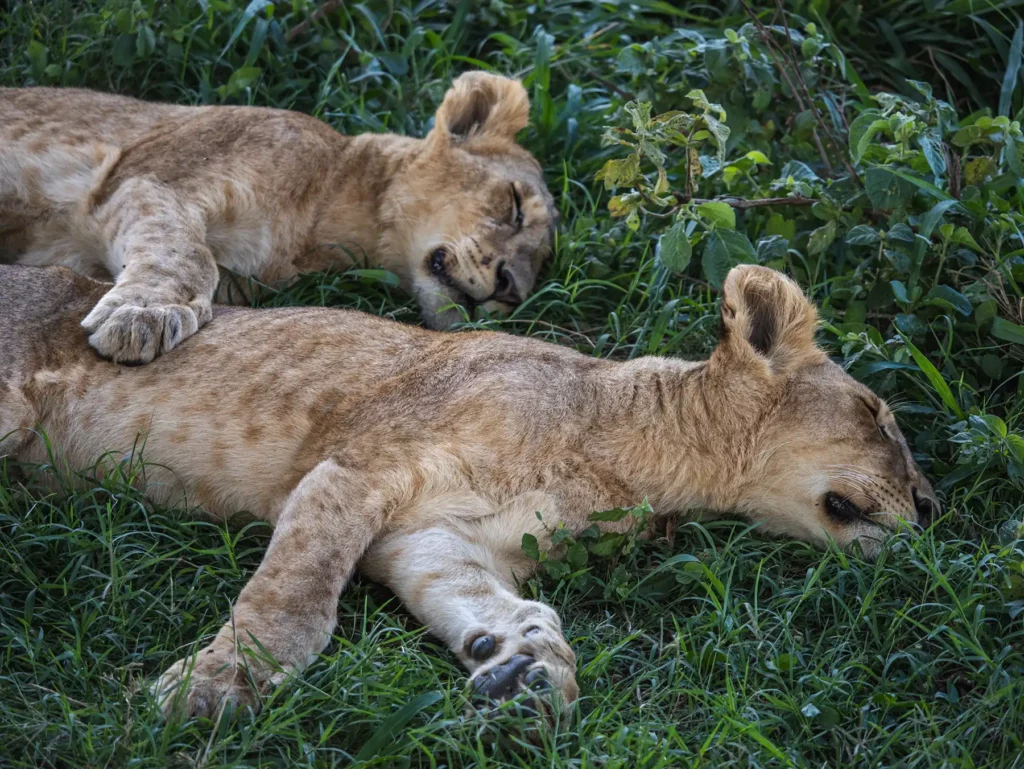
In this article I’m going to take you day-by-day through all five of my ultimate 3-day Tanzania safari itineraries, created according to my own experience and those of my favourite Tanzania guides.
I’ll provide guidance on the best time to visit Tanzania for each itinerary and share tips and tricks including how to avoid some of the mistakes I made such as a terrifying night-time taxi ride.
You’ll also find useful guidance on the costs of a Tanzania safari and how to find and book the best safari tour company for each itinerary option.
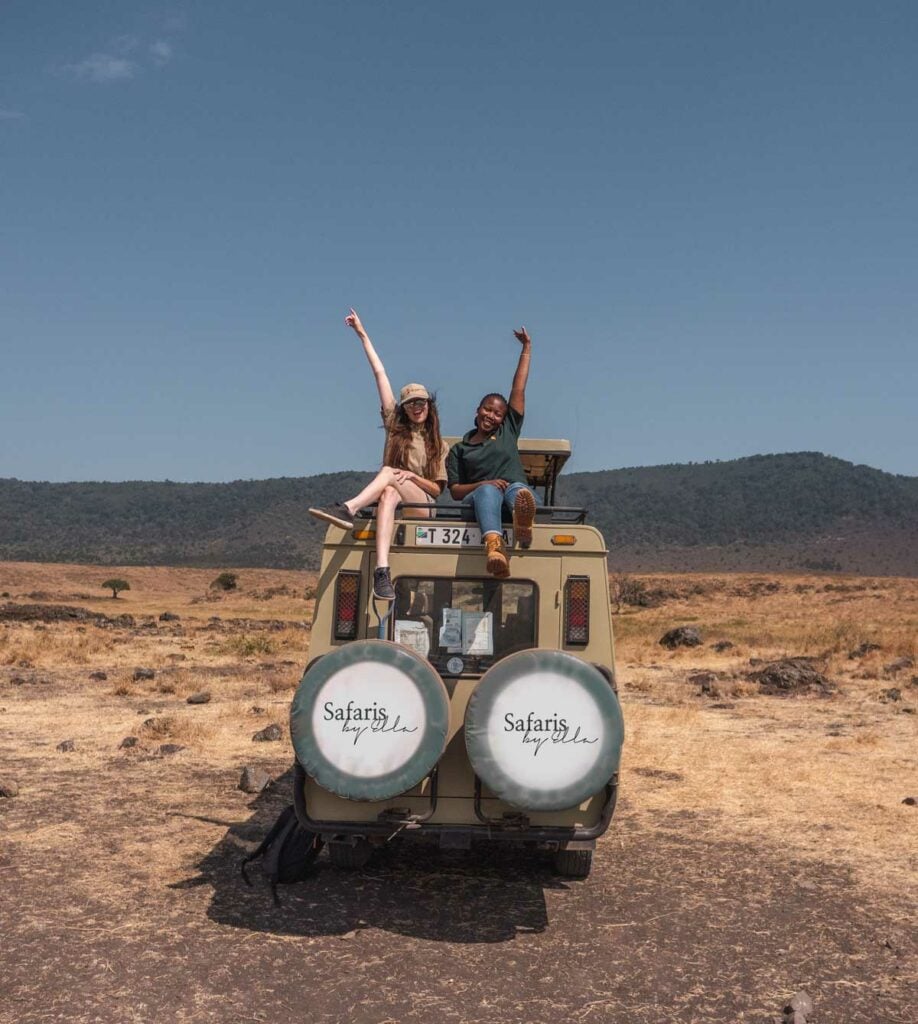
Plan Your Safari Adventure
Save time and ensure an incredible experience from the local safari companies I use to organise my own trips.
I’m here to make booking your perfect safari quick, easy and risk-free. It takes less than 1 minute to fill out the form and in under 48 hours you will receive multiple, no-obligation proposals from my favourite local tour operators with glowing online reviews.
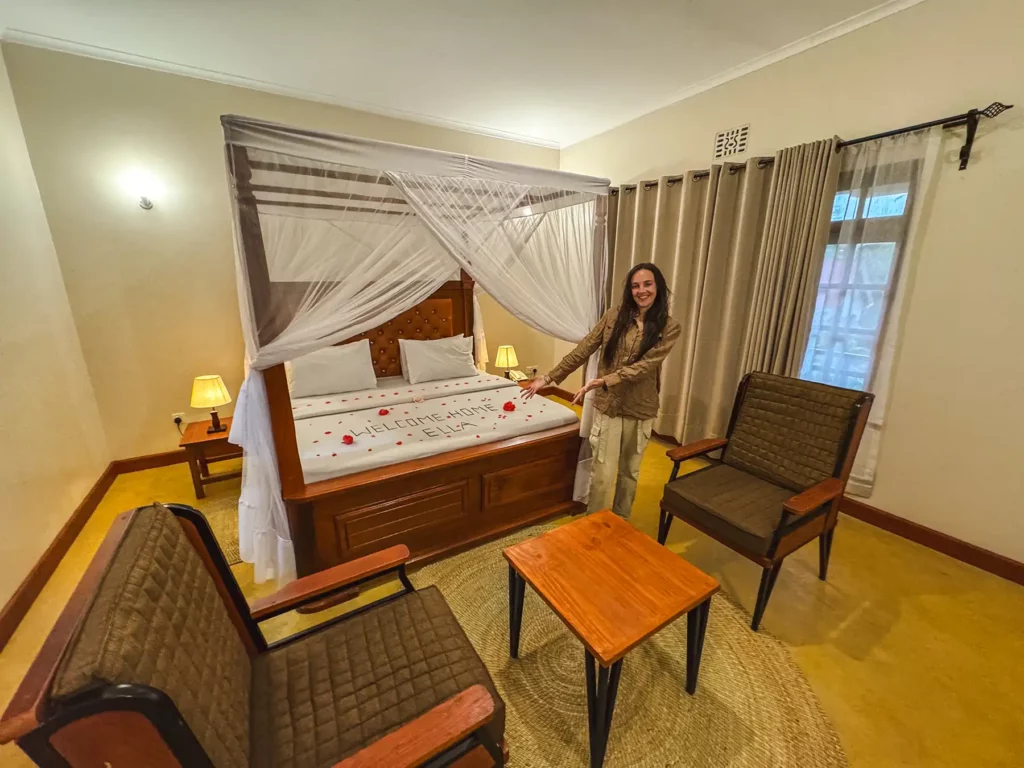
Five different 3-Day Tanzania Safari Itineraries
I’ve detailed five of my favourite 3-day Tanzania Itineraries below.
I’ve focused on Tanzania’s northern parks for my 3 day itineraries as the Northern Circuit contains some of the best and most popular parks in Tanzania.
The northern parks are also easily accessed from Arusha, home to Kilimanjaro International Airport, where most visitors fly into when visiting Tanzania.
Tanzania’s southern parks are drastically more spaced out and would usually require much longer than 3 days. The only exception would be flying directly into one of the southern parks from Dar es Salaam for a couple of days and then flying back. However, with the wildlife being more spaced out in these parks, I’m not sure I’d recommend them for such a short period.
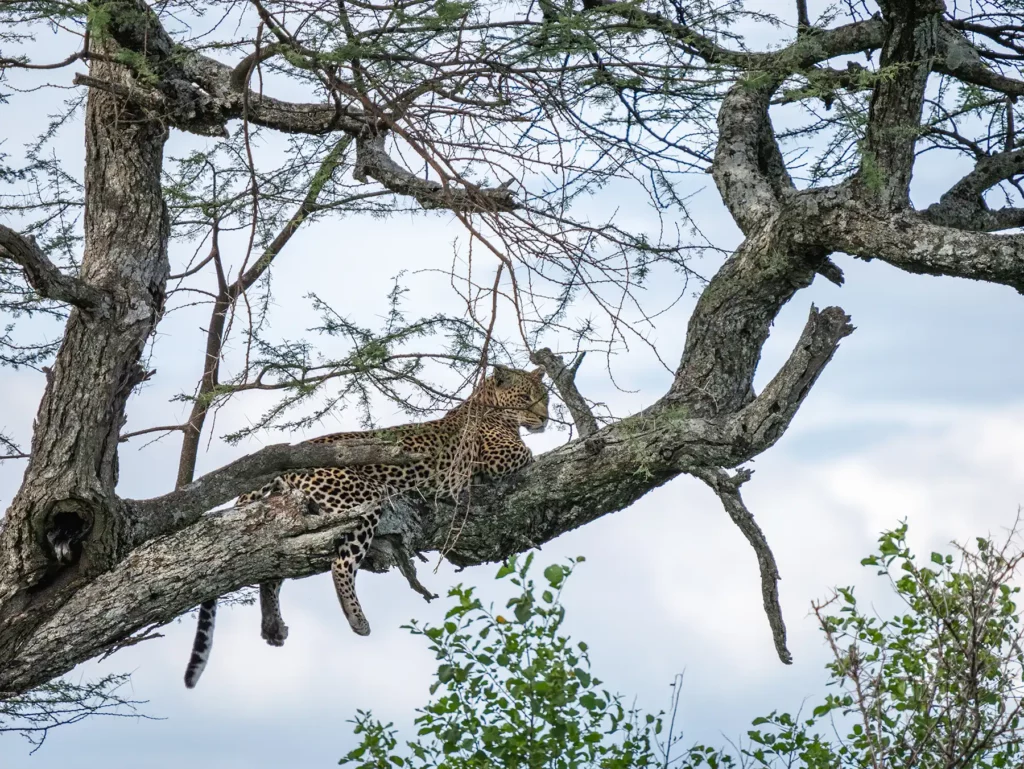
Option 1
3-Day Multi-Park Northern Circuit Safari Itinerary
This 3-day itinerary incorporates three Northern Circuit parks in just three days: Tarangire, Ngorongoro Crater and Lake Manyara.
This is a very popular 3-day itinerary as it allows you to visit three fantastic Northern Circuit parks via road without the need for internal flights and the associated extra costs.
If it’s your first time in Tanzania, then you can’t go wrong with this popular 3-day safari itinerary. It’s also the fixed itinerary for most 3-day group camping safaris, so it can still work well if you’re on a budget.
If you have the extra budget for internal flights on a small propeller plane (around $300 per person each way) and you’d rather visit the fourth and most famous of the Northern Circuit parks, the Serengeti, you would do this instead of Tarangire and Lake Manyara and fly directly there to avoid the 8 hour drive. For this option see my 3-Day Serengeti & Ngorongoro Crater Fly-in Safari Itinerary and 3-Day Great Migration Wildebeest River Crossing / Calving Safari Itinerary
Quick Facts
- Average driving time per day: 4.5 hours.
- Best times of year: Long dry season from June to October or the short dry season from January to February.
Itinerary Map for 3-Day Multi-Park Northern Circuit Safari
Itinerary starts and ends in Arusha.
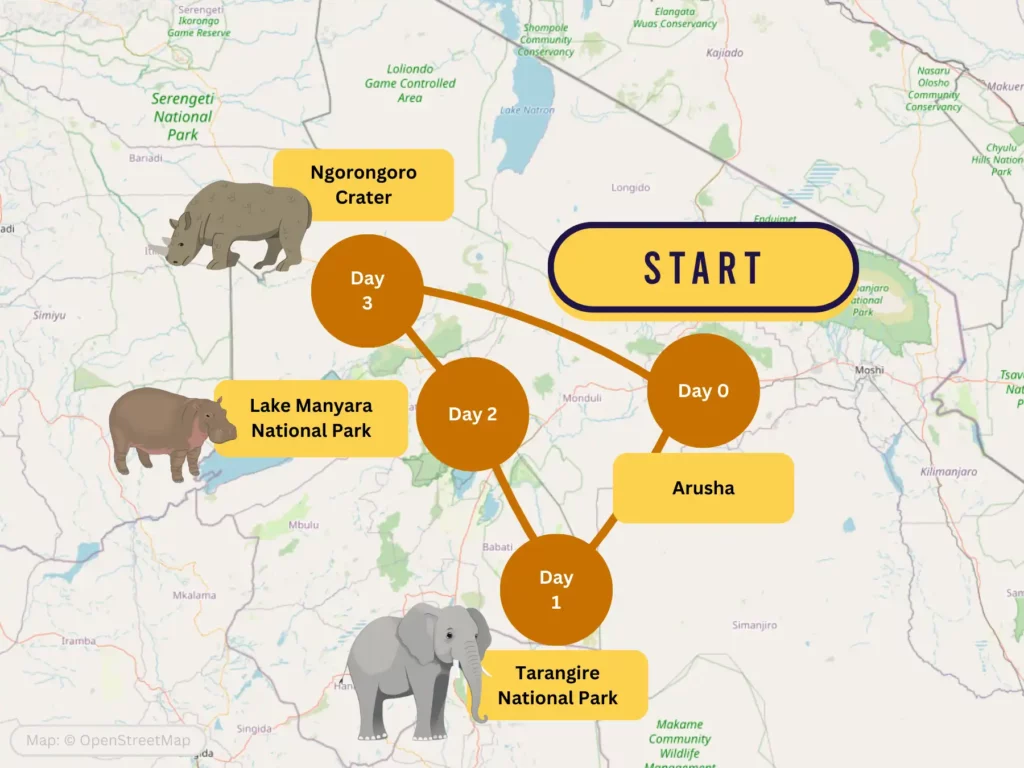
Day By Day Breakdown for the 3 Day Multi-Park Northern Circuit Itinerary
Day 1: Tarangire – total drive time 5.5 hrs (or 3 hours if you spend the night in Tarangire)
Embark on your adventure from Arusha, the entrance to Tanzania’s renowned Northern Safari Circuit. A scenic drive of approximately 3 hours westward from Arusha will lead you to the Northern Gate of Tarangire National Park.
Activities for Your Day in Tarangire National Park
You’ll spend the day with a thrilling game drive within the park.
The game drive can be complemented with a walking safari for those seeking a more intimate experience.
About Tarangire National Park
Established in 1970 and covering a large area of 2,850 km², Tarangire is Tanzania’s sixth-largest park. Named after the Tarangire River, which meanders through the park, Tarangire’s population of wildlife rely on this water source for survival during the dry season.
The park is famous for its huge herds of African elephants which can amount to 5,000 in total during the peak of the migration from July to October.
The landscape of Tarangire is adorned with ancient and distinctive baobab trees. The distinctive trees, with their swollen trunks and branches reaching out like roots, create a picturesque backdrop against the African sky.
Tips for Visiting Tarangire National Park
The best time to visit Tarangire is in the dry season when the migratory herds are present.
There are two lovely lunch spots in Tarangire where you can use the toilets and tuck into a packed lunch or hot lunch. Food will be arranged and brought by your safari company as there is no on-site catering.
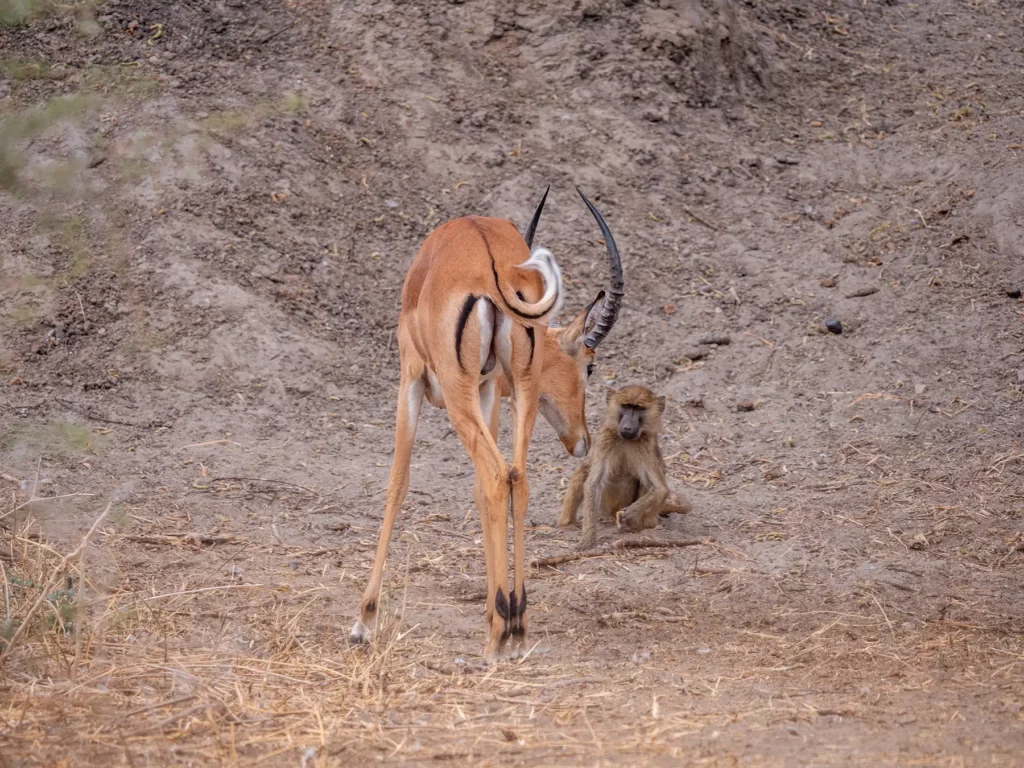
My Personal Experience in Tarangire National Park
In my opinion the slightly lesser known Tarangire is a must-visit park in Tanzania – I had an incredible safari in the park, which is one of the most wildlife-dense National Parks I’ve visited.
I loved every minute of watching huge African elephant herds – Tarangire is the best place in Tanzania to see African elephants and one of the best places in Africa along with Amboseli National Park in Kenya and Chobe National Park in Botswana.
A memorable moment for me was observing a group of elephants quenching their thirst at a watering hole. Witnessing a playful baby elephant joyfully rolling in the water was a heartwarming sight.
The park fees are also around 50% of the Serengeti making it a great value park to visit.
You can watch a video of my Tarangire safari experience on Youtube below.
Where to Spend the Night
You can spend the night in Tarangire which will allow you to have a second game drive in the park on your way to Manyara National Park tomorrow.
Alternatively, it’s more cost-effective vs in-park accommodation to drive for around 2.5 hours to accommodation in the Mto Wa Mbu area. Lake Manyara National Park is in Mto Wa Mbu, so this allows for a short 30 minutes drive to the gates for an early game drive in the park tomorrow.
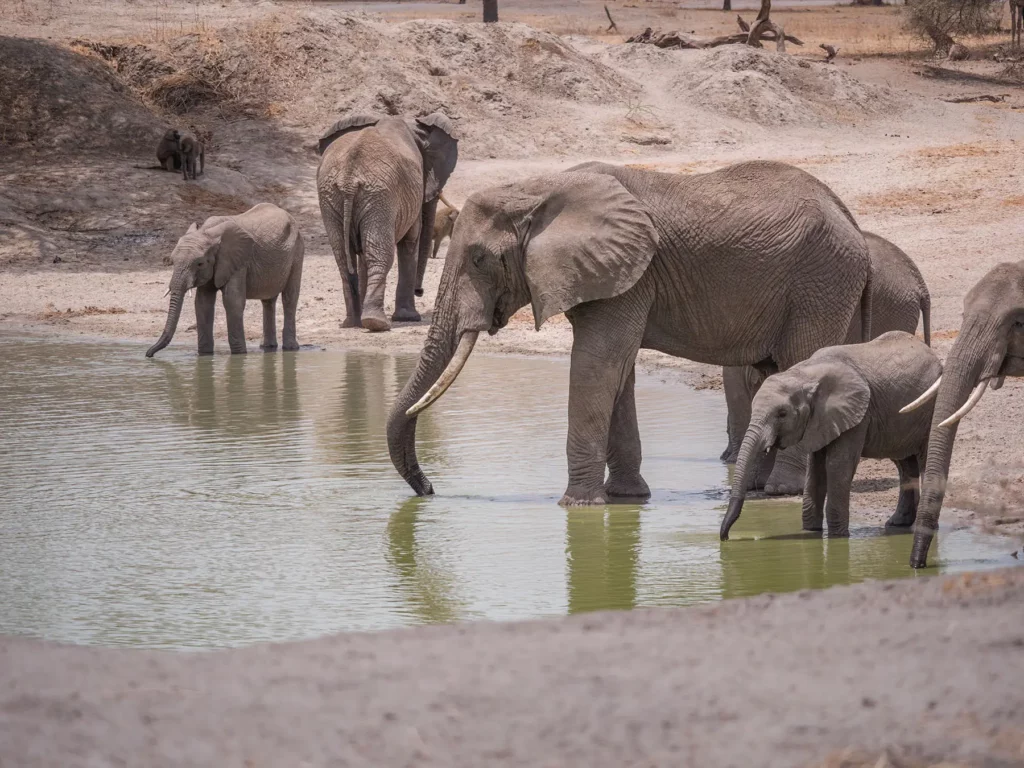
Day 2: Manyara National Park – total drive time 3.5 hrs (or 6.5hr if you spend the night in Tarangire)
Lake Manyara offers excellent value for park fees and is renowned for its tree-climbing lions, massive flocks of pink flamingos, and 250 other bird species. Additionally, the park provides an opportunity to witness the impacts of climate change, with the lake having expanded in recent years and engulfed significant portions of the surrounding forest.
From accommodation in the Mto Wa Mbu area it’s only around a 30 minute drive to the entrance gates to Lake Manyara National Park.
If you opted to spend the night in Tarangire National Park, then after your game drive to the gates of the park, it’s a further 3 hours or so to Lake Manyara.
Activities for Your Day in Manyara National Park
You’ll usually start off with a 3-4 hours game drive which should allow enough time to cover the whole of Lake Manyara National Park.
To view the park from a different perspective, there is a great tree top canopy walk which takes around 45 minutes.
The lake takes up a large part of the park and the best way to experience the lake is to take a canoe trip over the lake. You can see huge flocks of pelicans and pink flamingos and hear the sometimes not-so-distant sounds of hippos bellowing.
Finally, you can immerse yourself in Tanzania’s culture with a 1 hour visit to a local Maasai tribe where they will greet you with their famous jumping dance and show you around their traditional village.
About Lake Manyara National Park
In 1960 Lake Manyara was given National Park status to protect the large herds of elephants which wander through the park. Previously it was a game reserve which was formed in 1957.
Lake Manyara is quite different to many of the other national parks such as Tarangire in that it’s mostly covered by dense forest including acacia and sausage trees. These trees are home to the park’s residents including tree-climbing lions – one of the few places you can see them in Tanzania.
Although Lake Manyara National Park covers an area of 325 km2 (125 mi2), over half of this, 230 km2 (89 mi2) to be precise, is actually a large yet shallow lake.
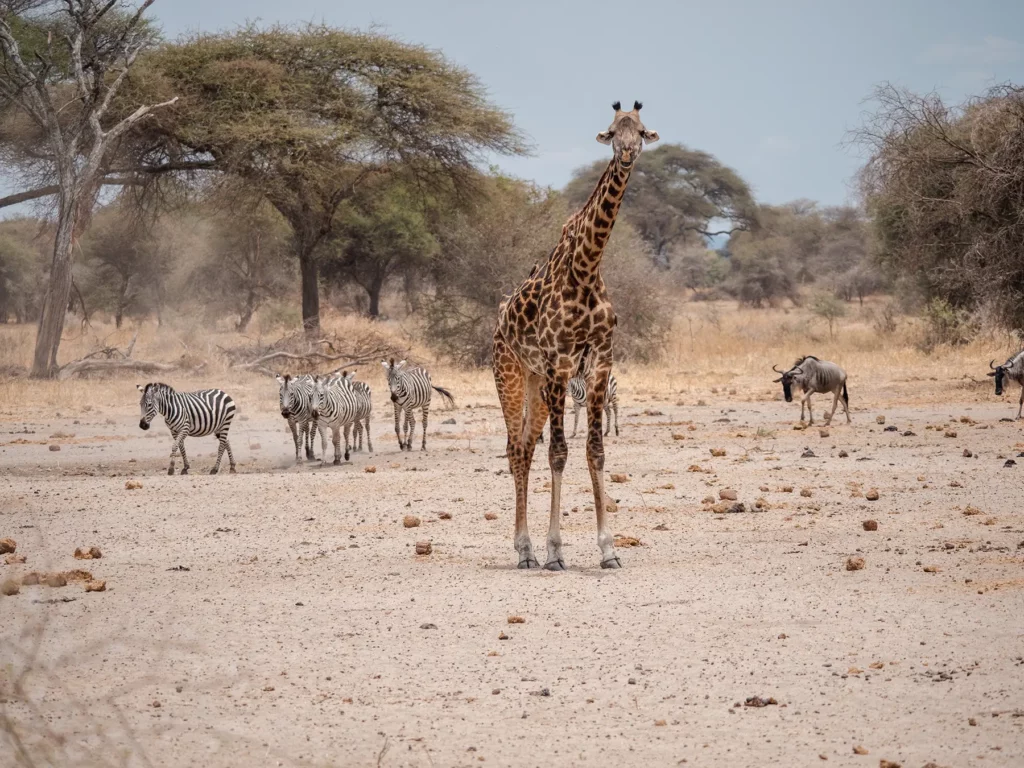
Tips for visiting Manyara National Park and Mto Wa Mbu
The lake is very shallow which means that during very dry spells the water levels can drop so low that it’s not possible to canoe. This will normally only occur around the middle of the long dry season in June / July.
Due to climate change the lake has swallowed up part of the forest, which can be seen by the tree standing upright in the water. For this reason I’d only recommend half a day driving around the park as it’s smaller than it once was. There are however, other great activities for the afternoon such as canoeing, visiting ta Massai boma or a cultural tour in Mto Wa Mbu which you can see in my Youtube video linked below
My Personal Experience in Lake Manyara National Park
I thoroughly enjoyed canoeing on Lake Manyara alongside local fishermen. The serene experience of being on the water without the noise of motors was incredibly soothing. Although hippos remained unseen, their distinctive calls echoed around me. Instead, I spotted playful vervet monkeys along the lake’s banks and observed Maasai herders guiding their cattle through the outskirts of the forest.
You can watch a video of my Lake Manyara canoe safari & Mto Wa Mbu tour on YouTube below.
Where to Spend the Night
It takes around 3 hours to reach the Ngorongoro Conservation area, home to the mysterious Ngorongoro Crater, where you’ll spend the night, usually on the rim of the crater ready for an early morning descent into the crater.
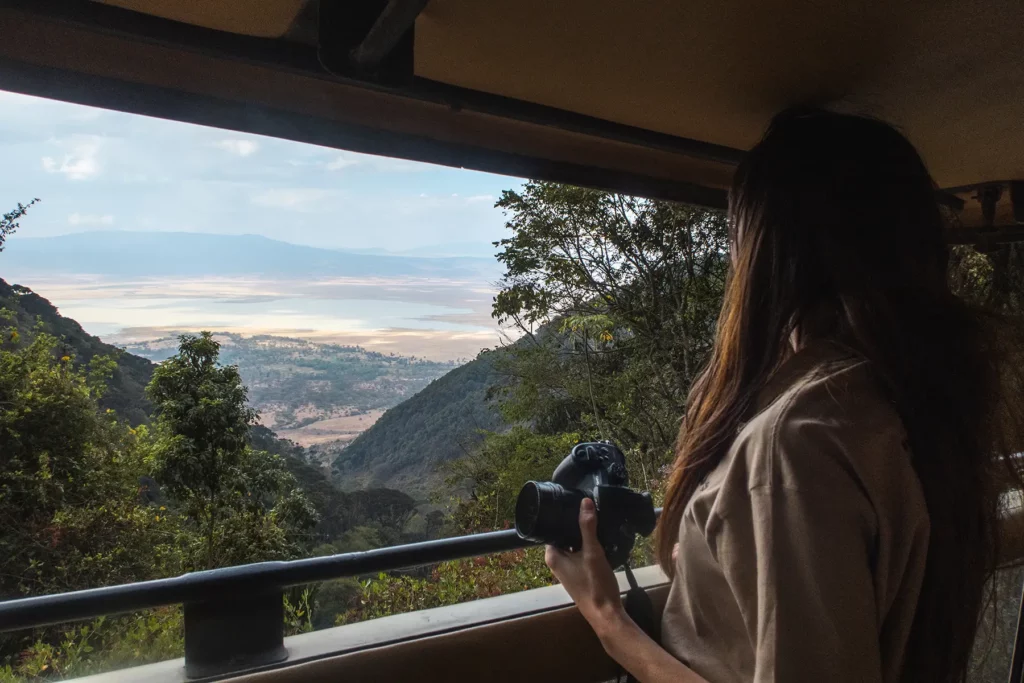
Day 3: Ngorongoro Crater (total drive time 4.5 hrs)
I’ve designed this itinerary to ensure you’re positioned on the rim of the crater to make an early morning decent into the crater possible (without having to get up at an obscene time), which will give you the best possible chance of seeing the rare black rhinos who congregate in the morning before they separate for the day.
From your accommodation, you’ll drive along the rim of the crater through the misty and dramatic forests. You’ll then begin your epic 2,000 meter descent into the base of the crater.
The Ngorongoro Crater is a truly unique place, with towering walls enclosing a vast, flat plane filled with an array of wildlife. As I descended into the crater I felt a sense of excitement as I entered what felt like a lost world.
Activities for Your Day in Ngorongoro Crater
Your morning will be dedicated to a game drive within the crater, and afterward, you’ll enjoy lunch on the shores of Lake Magadi. This beautiful alkaline lake serves as a habitat for flamingos, hippos and prehistoric looking stalks.
Time permitting, you can take part in a guided walk with the Maasai along the rim of the crater, where you will be treated to breathtaking views and gain insights into the Maasai community’s profound connection with the crater.
About Ngorongoro Crater
Established in 1959, the wider Ngorongoro Conservation Area, a UNESCO world heritage site, is the only conservation in Tanzania which allows the coexistence of wildlife with semi-nomadic Maasai pastoralists.
However, no one is allowed to live inside the crater itself which is a massive caldera formed millions of years ago by the collapse of a volcano.
The Maasai Tribe named the crater after the sound created by the cowbell, known as “ngoro ngoro,” echoing as their cattle moved about the crater.
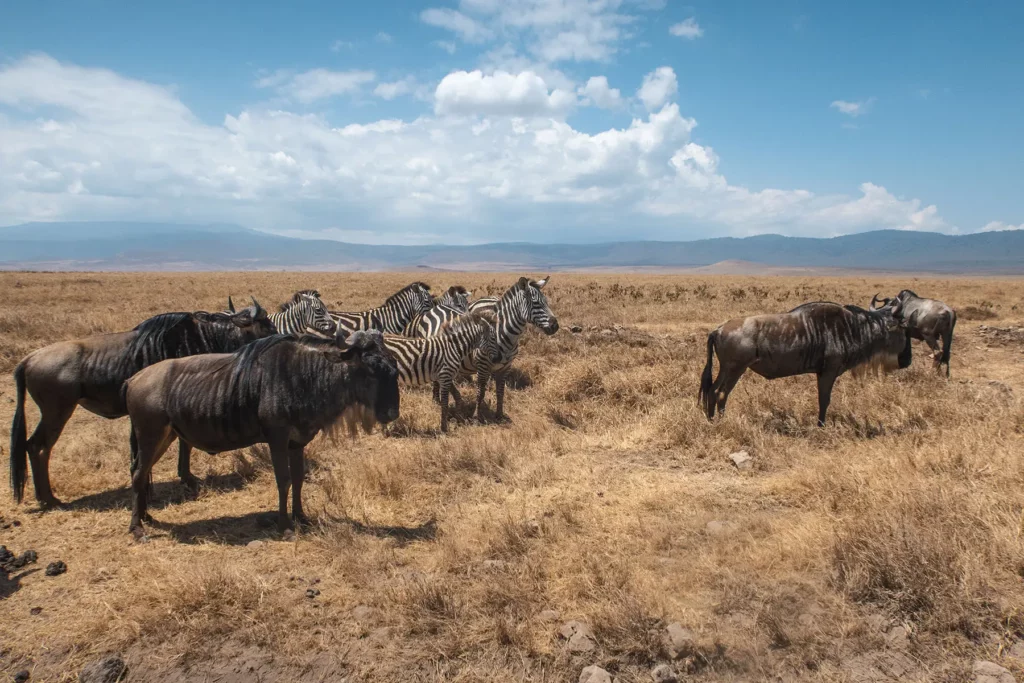
Tips for Visiting Ngorongoro Crater
There are 30 rare black rhinos which call the crater home. The rhinos usually congregate together around sunrise before splitting off in search of food, making this the best time to spot one.
I’d recommend enjoying a pre-prepared hot lunch on the shores of Lake Magadi within the crater—an arrangement your safari company can easily facilitate. Enjoy the picturesque scene of lesser flamingos in flocks and the occasional, prehistoric-looking marabou stork.
Since the majority of wildlife remains in the crater throughout the year, Ngorongoro Crater is great to visit year-round. However, the optimal periods are during the brief dry spell in January and February, ideal for observing baby animals, and the extended dry period from June to October when shorter grass on the crater floor improves wildlife visibility.
My Personal Experience in Ngorongoro Crater
Ngorongoro Crater stood out as a highlight during my Tanzania adventure. Driving along the crater rim, we became immersed in mist, generating an eerie yet electrifying atmosphere.
My first view of the crater itself is one that will stay with me for the rest of my life. It evoked a sense of stepping into a prehistoric, lost world akin to Jurassic Park.
The floor of the crater is quite barren, especially in the dry season, which makes wildlife spotting very easy. Upon entering the crater, I sighted a solitary hyena, followed by a cluster of buffalos. Soon after, I found myself encircled by herds of wildebeest and zebras.
Without a doubt the highlight of my safari in Ngorongoro Crater was stumbling across a family of servals. Servals are one of the smaller cats that you can see on the savannah and due to their nighttime habits they’re pretty rare to see in the daytime. You can imagine my delight then when I watched them pounce on small rodents which were scurrying through the grass. Servals are famous for their ability to leap high into the air to catch birds mid-flight. They can jump up to 15 feet in the air.
You can watch a video of my Ngorongoro Crater safari experience on YouTube below.
Where to Spend the Night
After the day’s activities you’ll drive back to Arusha for the night which takes around 4 hours.
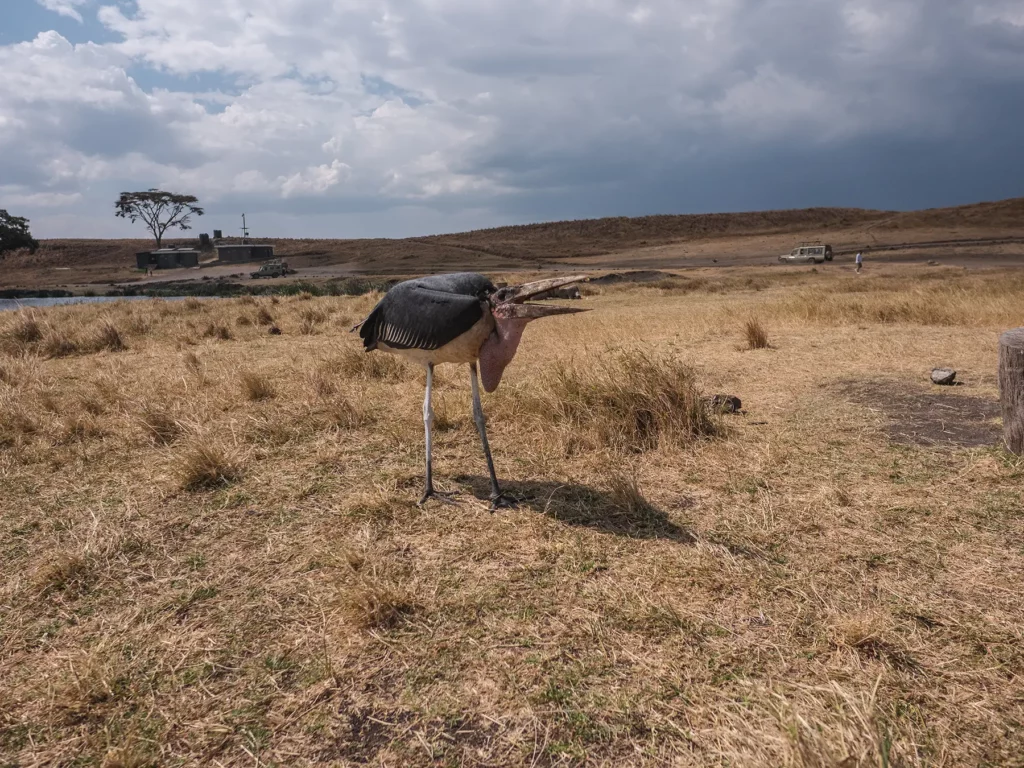
Costs
For this 3-day itinerary, full board Tanzania safari costs for private safaris start at around $330 per person per day for 4 people and $360 for two people. Prices assume working with a small local safari company and will vary depending on the level of accommodation chosen and number of people sharing the safari truck.
Prices per day tend to be higher the shorter the safari as with longer safaris you’ll usually have cultural, rest and beach days which incur no park fees and thus reduce the average cost per day.
For budget and mid-range safaris, park fees make up the biggest proportion of the total safari costs.
In Tanzania it’s normal practice for the safari companies to arrange the whole trip on a full board basis and give you a single price for your safari. However, if your interested, let me give you a quick example of how the pricing breaks down:
Ngorongoro Crater is the most expensive of Tanzania’s safari parks and entry fees for one safari truck plus 2 adults at the time of writing are $613 + 18% Tanzania tax = $723.34.
On top of the park fees, you have around $350 per day for the private safari truck and your driver / guide. This is shared between you and anyone else in your group such as your partner.
That’s a running total of $536.5 per person for that particular day before adding accommodation and other costs.
Due to the high park fees, local tour companies don’t usually make much profit on the safaris. In my experience their profit margins are around 10% – 15% and much of this is offset against the special trade prices they receive for accommodation, so they end up working out very cost effectively.
After taking off the safari companies’ overheads and direct staff costs for organising the trips and other fees I would estimate they are only making around 5% profit. Therefore, although Tanzania safari costs can seem high, this is largely down to the high park fees which go towards conserving the animals and ecosystems for future generations to enjoy.
Recommended Booking Options For Your 3-Day Multi-Park Northern Circuit Itinerary
Private Safari
Most popular & best experience – typical prices for this itinerary start from $330 per person per day.
Visit safarisbyella.com for free quotes from trustworthy local tour companies I use to book my own trips.
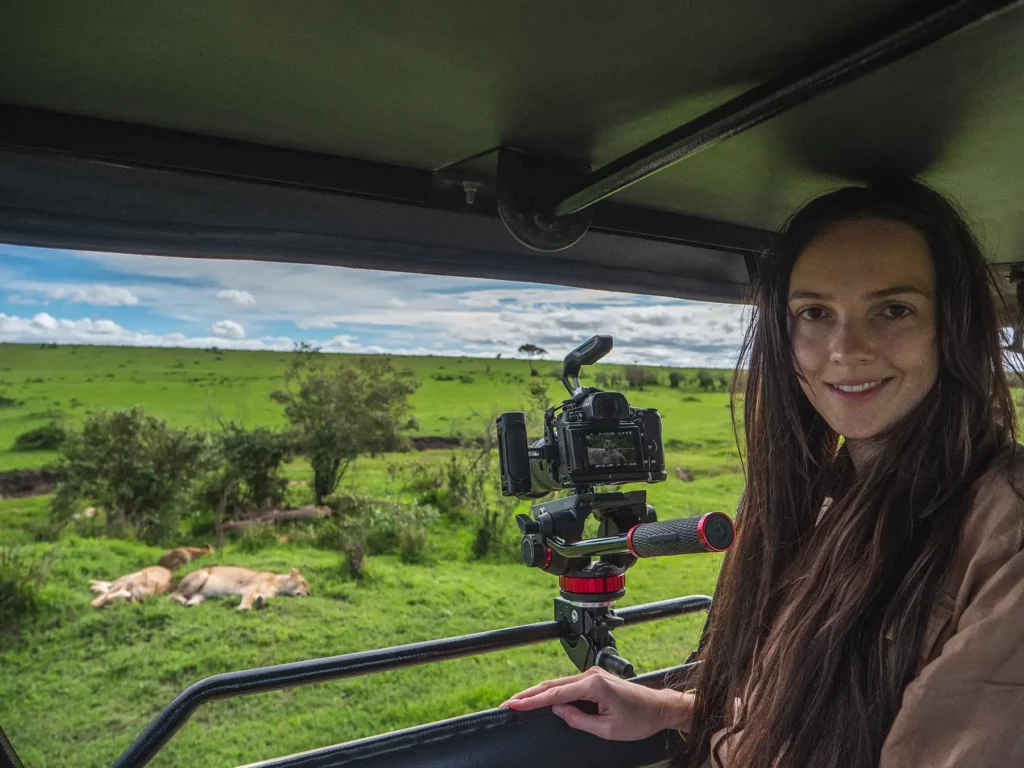
Group (Shared) Safari – Usually Camping
Good for budget or solo travellers – from $187 per person per day.
My recommended Tanzania tour operators only provide private safaris, however, I’ve listed the best and most similar group options for this itinerary, on SafariBookings below.
I could not find any group safaris following this or any similar itineraries. See my guide(s) below for better group budget options.
Click the link below to request quotes for the group safari options on the SafariBookings website.
3-Day Budget Camping Group Safari
3-Day Budget Lodges Group Safari (Option 1)
3-Day Budget Lodges Group Safari (Option 2)
View All My Recomended Group Options Following a Similar Itinerary
Jump back to the table of contents to select another 3 day itinerary to view or keep scrolling to read the next itinerary.
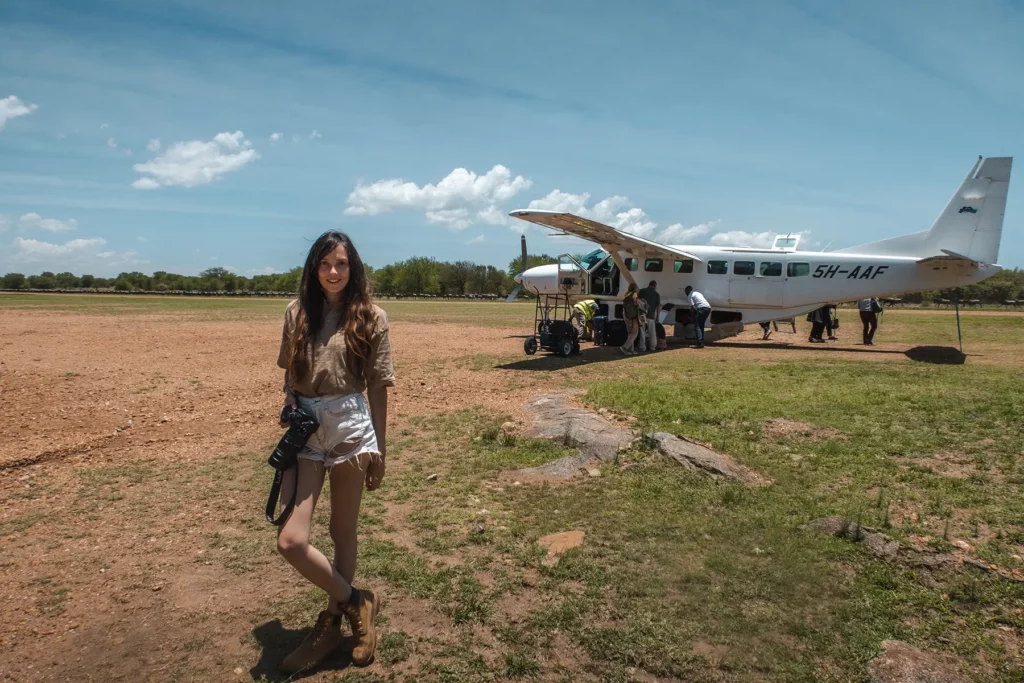
Option 2
3-Day Serengeti & Ngorongoro Crater Fly-in Safari Itinerary
This 3-day itinerary will take you to the two best safari parks in Tanzania: Serengeti and Ngorongoro Crater. However, it’s not a cheap itinerary. Let me explain why:
The vast Serengeti is one of the most famous safari parks in the world. However, it’s an 8 hour drive to central Serengeti from Arusha and the north is a further 5 hours by car.
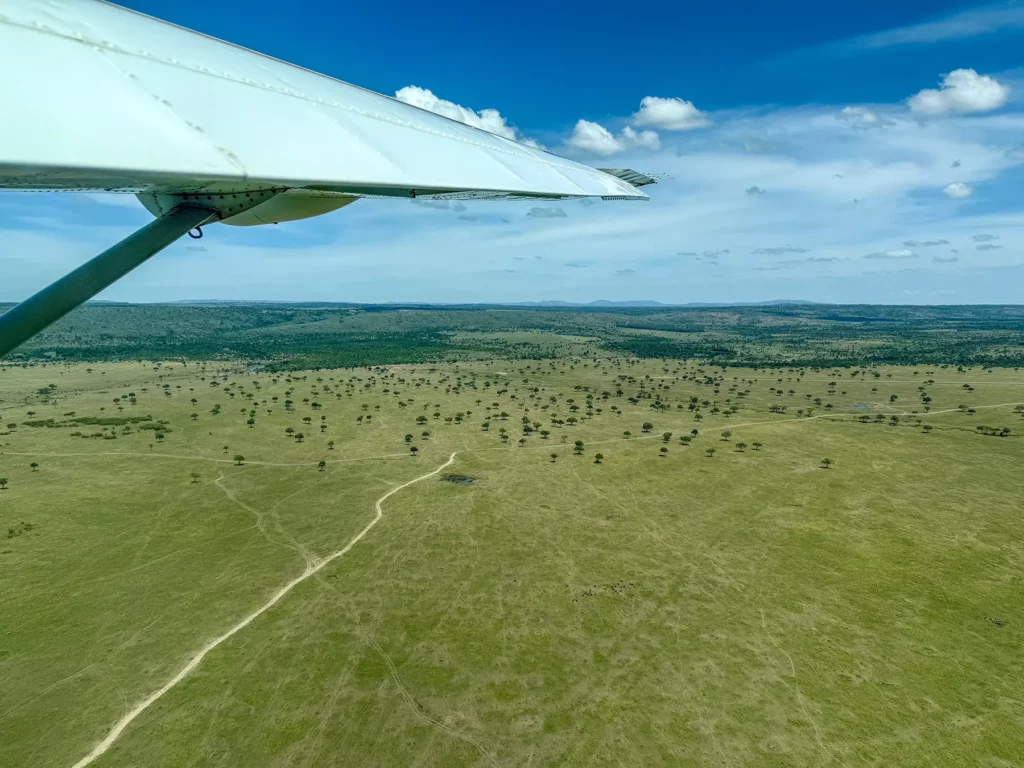
For this reason It’s only really viable on a 3-day itinerary if you fly on a small propeller plane directly to the Serengeti from Arusha aka a ‘fly-in safari’. Otherwise you’d be spending most of your three day safari driving to and from the park.
Fly-in safaris are popular as they avoid long drives and allow you to spend more time on safari. However, they will increase your 3-day fly-in safari costs along with the higher park fees payable for entry into the Serengeti and Ngorongoro Crater.
If you’ve got the budget, then this fantastic 3 day option. However, if you’ve visiting in January – February or July – Sept you might also want to consider my 3-Day Wildebeest Great Migration Safari Itinerary too.
Quick Facts
- Average driving time per day: 2.3 hours.
- Best times of year: Long dry season from June to October or the short dry season from January to February.
Itinerary Map for 3 Day Serengeti & Ngorongoro Crater Fly-in Safari
Itinerary starts and ends in Arusha.
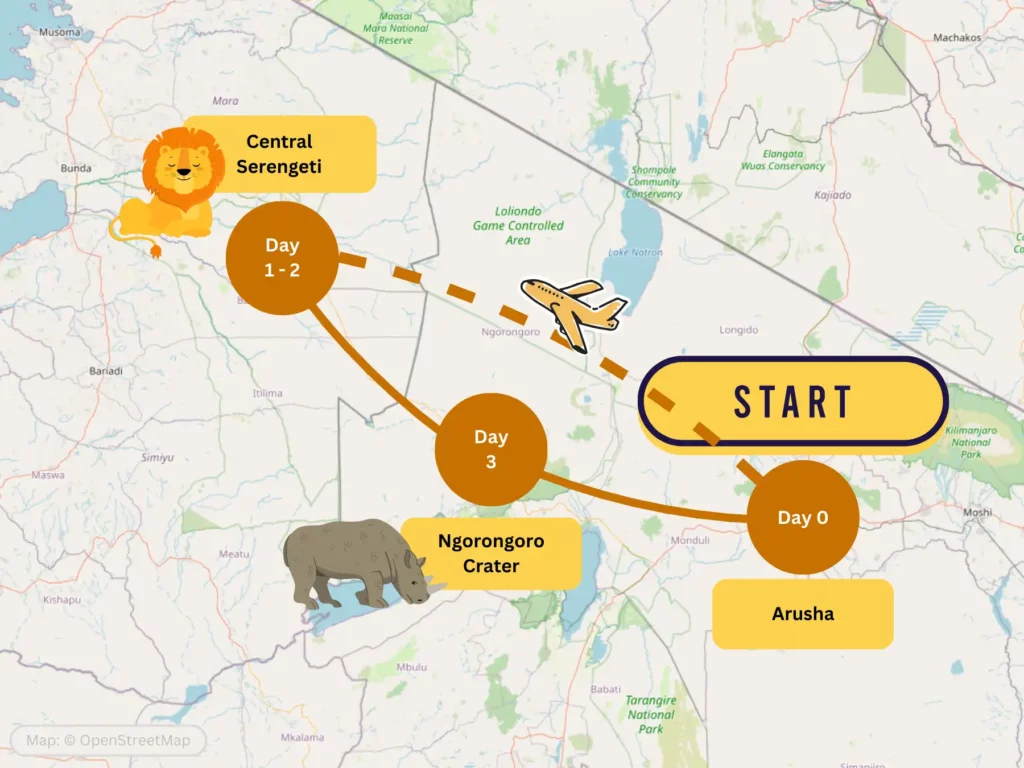
Day By Day Breakdown for the 3-Day Multi-Park Northern Circuit Itinerary
Day 1 – 2: Seronera (Central Serengeti) – total drive time 2.5 hrs* + 1 hour flight
*2 hours of the driving is on day 2
You’ll start from Arusha, known as the gateway to the northern Circuit. From Kilimanjaro International Airport in Arusha, you’ll board a small propeller plane and begin your short 1 hour flight to Seronera airstrip in central Serengeti.
You’ll then be met by your driver guide in a safari truck at the airstrip and your Serengeti adventure will begin.
Activities for Your Day in Seronera (Central Serengeti)
You’ll spend the morning on an exciting game drive through the endless planes and then call at your accommodation within the park for lunch before embarking on an afternoon game drive.
On the second day you’ll go on a morning game drive.
Balloon safaris (normally around $450-550 per person) are very popular in central Serengeti and run daily before sunrise, subject to calm weather. Although they’re not cheap, it’s an incredible once-in-a-lifetime experience to effortlessly drift above the African wilderness, with the possibility of witnessing the great migration from the air.
About Seronera (Central Serengeti)
The world-famous Serengeti which means ‘endless plains’ in the local Maasai language, became a national park in 1940 and is known for the Great Wildebeest Migration as well as its large lion population.
The park boasts all of the Big Five and is absolutely huge, spanning 30,000 km² and dwarfing the neighbouring Masai Mara which sits on the northern side of the Mara River in northern Serengeti.
To give you a sense of the scale, the Serengeti is 8 times bigger than Kenya’s Maasai Mara.
The great Migration takes place throughout the year and incorporates 1.5 million blue wildebeests along with zebras, Thomson’s gazelle and eland.
The Serengeti is home to the largest lion population in Africa and central Serengeti has the highest destiny of predators. This density gives you a great opportunity to see lions as well as having the chance to see cheetahs and leopards.
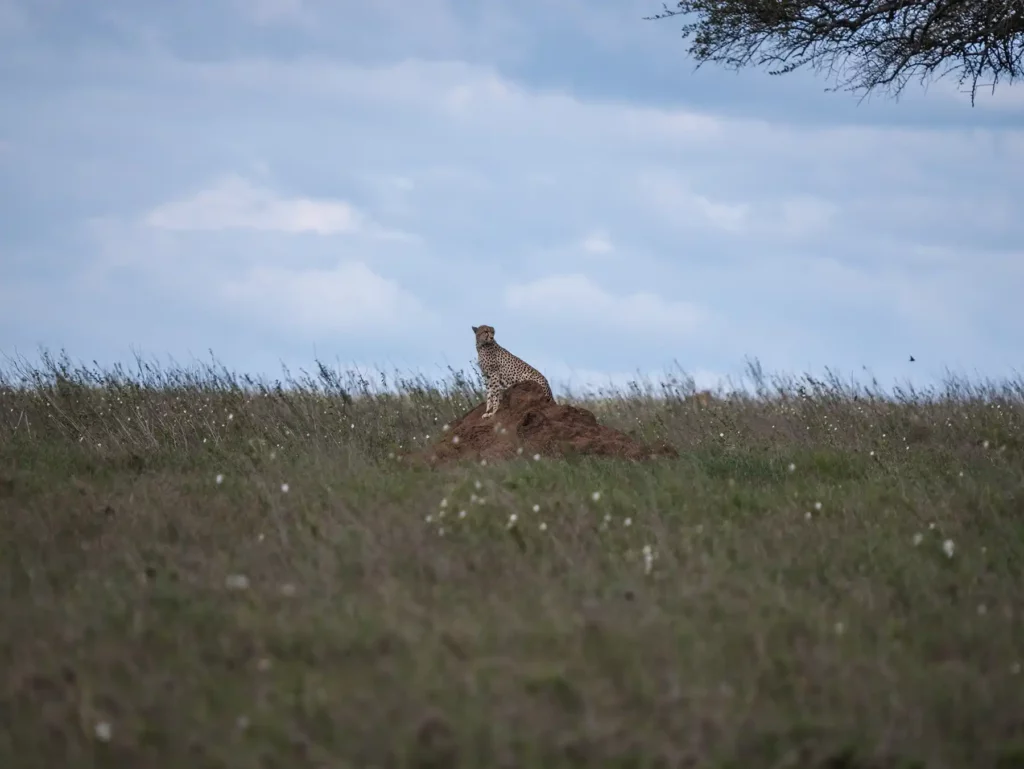
Tips for Visiting Seronera (Central Serengeti)
Make sure to understand what’s happening with the great migration at the time of year you’re visiting to optimise your trip. Generally speaking, the best time to visit the Serengeti is during the dry season from June to October or January and February.
Stay at accommodation within the park to avoid long drive times. Due to the massive scale of the Serengeti, If you stay at accommodation outside the park, in many cases you’ll waste hours getting to the prime wildlife viewing locations. Staying in the park is more expensive as there are Serengeti overnight park fees included in the rates but it’s a price worth paying.
Tented camps offer a more intimate safari experience with incredible sounds of wildlife in the evening and throughout the night. You’ll feel closer to nature whilst being safe as the camps I’ve visited always had night time guards. I heard the hyenas whooping as well as many other animals which added to my experience. Tented camps typically have normal beds, western toilets and hot showers.
A game drive first thing in the morning around sunrise gives the best opportunity to see predators hunting before they rest in the heat of the day.
Where to Spend the Night
You’ll spend the night of day 1 in the Serengeti.
After your game drives on day 2, you’ll drive to accommodation on the rim of the Ngorongoro Crater in the Ngorongoro Highlands which sets you up for an early descent into the crater on day 3.
My Experience in the Serengeti National Park
I’ve been to the Serengeti in a few occasions now and can confidently say it’s my favourite national park in the world! The landscape itself is simply breathtaking and I always see such a high density of animals here.
I’ve had a number of memorable sightings including of two male cheetahs devouring a freshly-caught wildebeest, a lioness chasing a zebra and, of course, the renowned wildebeest river crossing.
You can watch a video of my wildebeest river crossing experience below.
You can watch my video on finding the big cats of the Serengeti below.
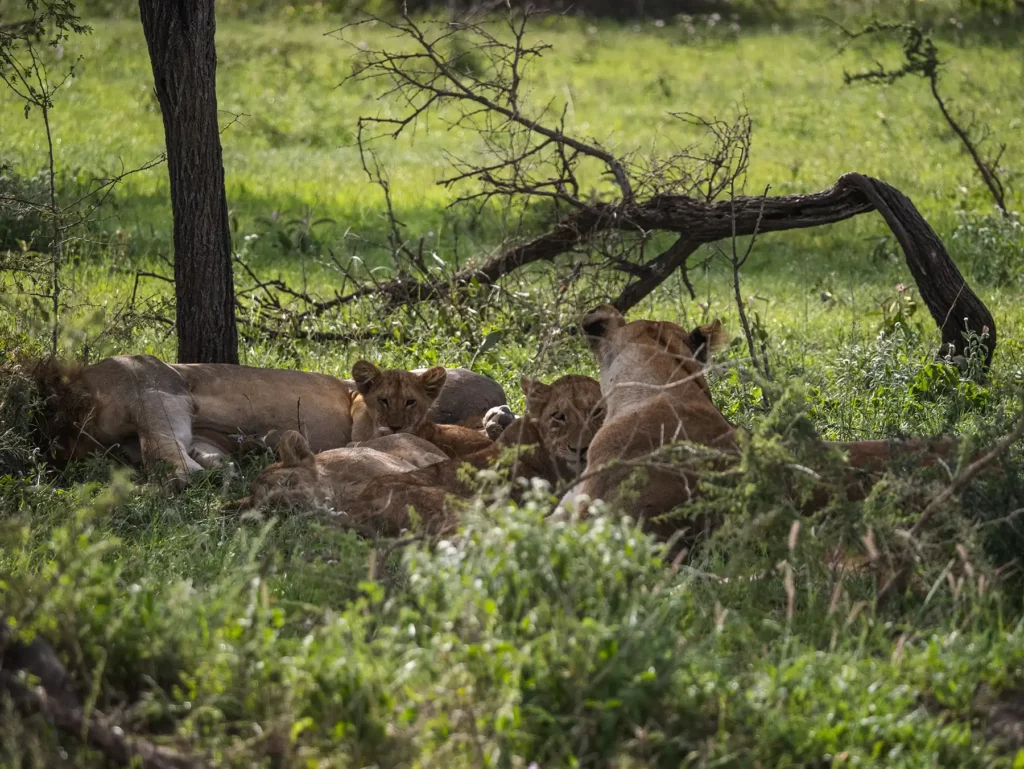
Day 3: Ngorongoro Crater – total drive time 4.5 hrs
Ngorongoro Crater ranks as one of my most memorable safari experiences as the location is so unique and epic – you’re in for a treat.
As with my other 3 day itineraries including the crater, I’ve crafted this itinerary to ensure you’re positioned for an early morning game drive in the crater which not only beats the crowds but gives you the best possible change of seeing one or more of the 30 rare black rhinos which inhabit the crater.
At the end of the day you’ll drive back to Arusha.
Activities for Your Day in Ngorongoro Crater
You’ll spend the morning on a game drive in the crater.
You can have a hot or cold pre-prepared lunch within the crater on the shores of Lake Magadi.
After lunch you can either spend more time game driving in the crater or stretch your legs on a walking safari with the Maasai around the crater rim where you’ll learn more about the Maasai’s cultural connections with the crater.
About Ngorongoro Crater
Ngorongoro Crater is believed to have been formed around 2.5 million years ago when a volcano erupted and collapsed inwards leaving the crater known as a caldera in its place.
The floor of the crater is inhabited by a wide array of wildlife including rare black rhinos, elephants, leopards and the densest population of lions in the world.
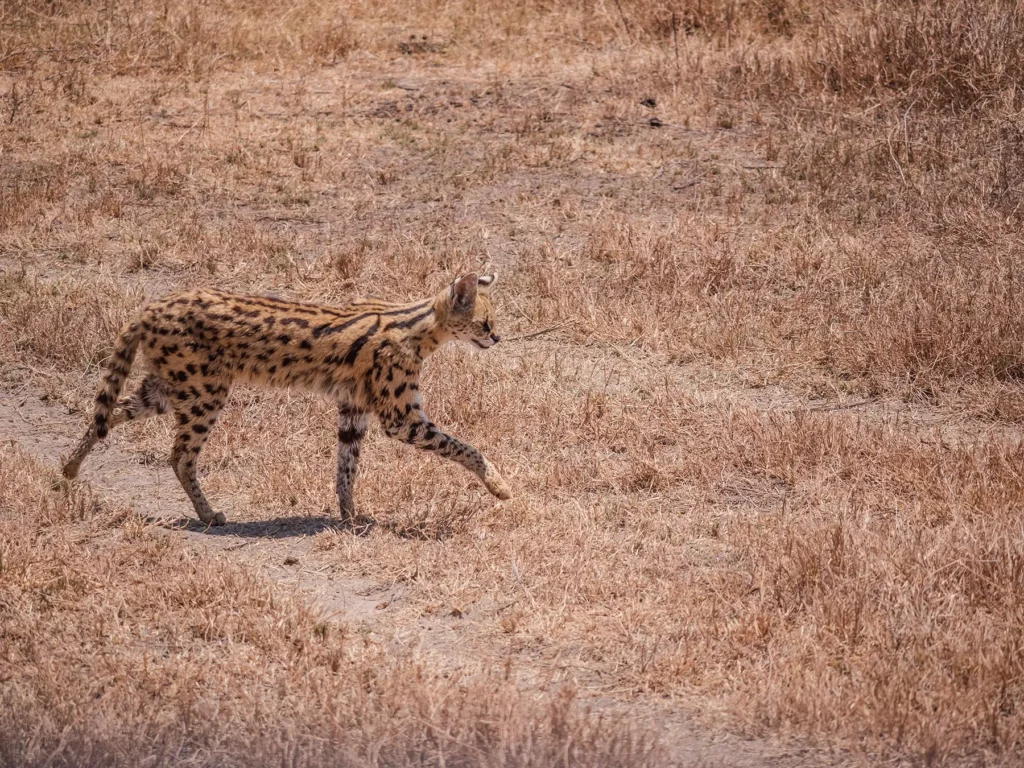
Tips for Visiting Ngorongoro Crater
Ngorongoro Crater is great to visit year-round as most of the animals don’t migrate. However, if you want to see baby animals then the short dry season from January to February is ideal. For the best wildlife visibility, the long dry season from June to October means shorter grass on the crater floor which makes wildlife easier to spot.
I’d recommend having lunch in the crater, on the banks of Lake Magadi, a shallow soda lake ringed by extinct volcanoes. you’ll be surrounded by great flocks of pink flamingos and you might even be visited by the occasional prehistoric looking stalk.
My Personal Experience in Ngorongoro Crater
Ngorongoro Crater is like nowhere else on earth. When I first laid eyes on the crater from the towering crater walls, the beauty of it took my breath away. It’s like an enchanted lost word, concealed by forest-coated walls.
On my safari I was able to spot a variety of wildlife. I saw elephants foraging in the forests on the fringes of the crater, a pride of lions resting beside a stream and a great herd of buffalo. The two highlights for me however was catching my first ever glimpse of servals in the wild and coming across a golden jackal which is actually a wolf.
You can watch a video of my Ngorongoro Crater safari experience on YouTube.
Where to Spend the Night
At the end of the day, you’ll head back to Arusha by road which takes around 4 hours.
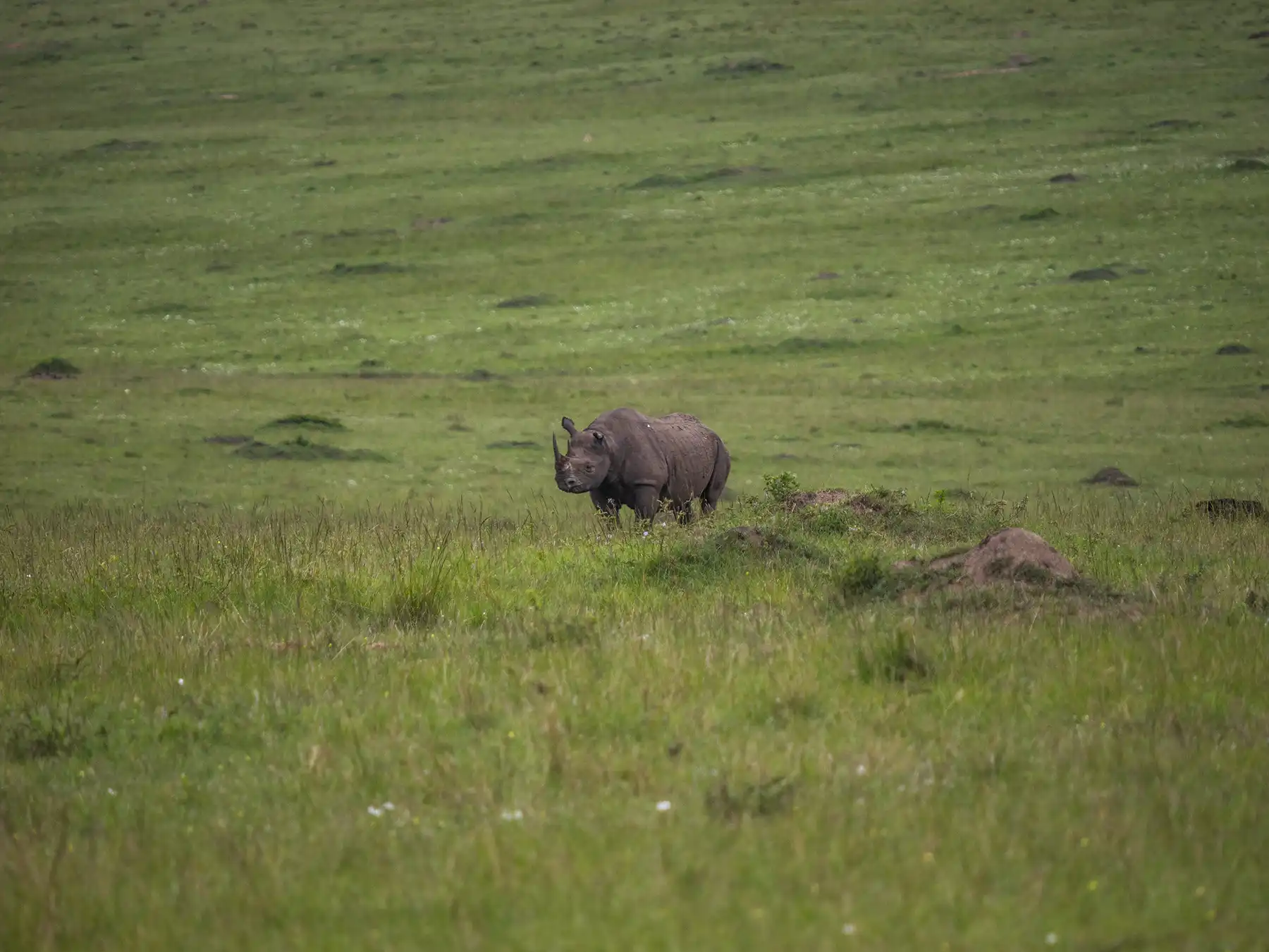
Costs
Compared to the first 3-day itinerary, this second itinerary has a couple of extra costs which make it more expensive:
- Internal flight between Arusha and Central Serengeti – a guide price for 1 person flying one-way to Seronera Airstrip (Central Serengeti) from Arusha is about $300 and takes around 1 hour.
- Serengeti park fees, which are higher than Tarangire plus Serengeti overnight fees for accommodation in the park.
For this 3 day itinerary, full board Tanzania safari costs for private safaris start at around $500 per person per day for 4 people and $550 for two people. Prices assume working with a small local safari company and will vary depending on the level of accommodation chosen and number of people sharing the safari truck.
Recommended Booking Options For Your 3-Day Serengeti & Ngorongoro Crater Fly-in Safari Itinerary
Private Safari
Most popular & best experience – typical prices for this itinerary start from $500 per person per day.
Visit safarisbyella.com for free quotes from trustworthy local tour companies I use to book my own trips.

Group (Shared) Safari – Usually Camping
Good for budget or solo travellers – from $220 per person per day.
My recommended Tanzania tour operators only provide private safaris, however, I’ve listed the best and most similar group options for this itinerary, on SafariBookings below.
Group safari options currently available have no internal flights (to reduce costs) so require an 8 hour drive to Serengeti.
Click the link below to request quotes for the group safari options on the SafariBookings website.
3-Day Budget Camping Group Safari (Option 1)
3-Day Budget Camping Group Safari (Option 2)
3-Day Budget Camping Group Safari (Option 3)
View All My Recomended Group Options Following a Similar Itinerary
Jump back to the table of contents to select another 3 day itinerary to view or keep scrolling to read the next itinerary.
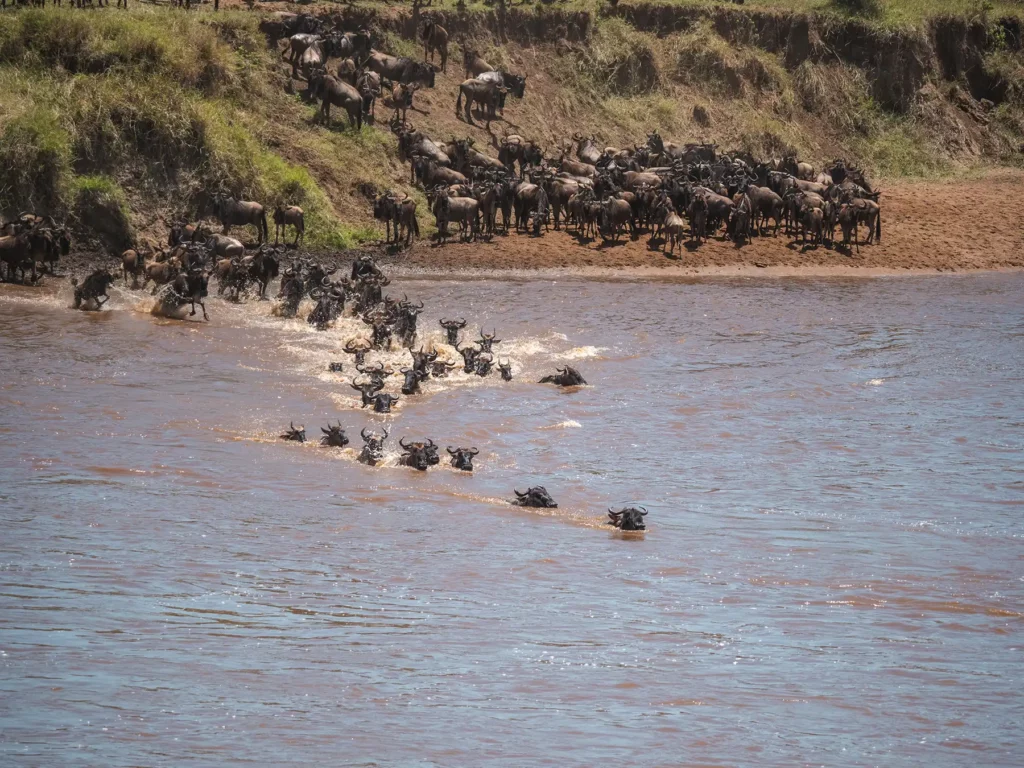
Option 3
3-Day Great Migration Wildebeest River Crossing / Calving Safari Itinerary
The Great Wildebeest Migration in Tanzania and Kenya is one of the wonders of the natural world – this 3 day itinerary is going to take you right into the heart of the action.
Viewing part of the great migration is simply breathtaking and it’s the last opportunity to witness a wildlife migration of this scale anywhere on earth.
The Great Migration takes place all year round as 1.5 million blue wildebeests along with zebras make the long and sometimes perilous journey across the Serengeti and Maasai Mara.
There are a number of key events in the Great Wildebeest Migration which take place at certain times of year. Exact timings can vary according to the timings of the rains.
January and February: The wildebeest calving season with up to 8,000 baby’s wildebeest’s born each day and related big cat activity. This takes place on the Ndutu Planes in Southern Serengeti and the Ngorongoro Conservation area.
May to July: The Grumeti River crossing where millions of wildebeests cross the crocodile-infested river in Western Serengeti
Mid-July to late September or mid-October to mid-November: The pinnacle of the Great Migration, the Mara River crossing in northern Serengeti. Millions of Wildebeests cross over the crocodile-infested Mara River travelling between the Maasai Mara in Kenya and the Serengeti In Tanzania. This can be viewed from Kogatende (northern Serengeti) or southern Masai Mara.
For the January / February calving season you could get away with driving as it’s in the south of the Serengeti so around 5-6 hours drive. However, for the river crossings, you’d need to fly as for example, the Mara River crossing is in northern Serengeti so it could take 13 hours to drive from Arusha which isn’t practical on a 3 day itinerary. On a longer itinerary you’d tend to break up the driving over multiple days.
Quick Facts
- Average driving time per day: <0.5 hours.
- Best times of year: The highlights of the migration take place around: January to February, May to July, mid-July to late September and mid-October to mid-November
Itinerary Map for 3-Day Great Migration Safari Itinerary
Itinerary starts and ends in Arusha.
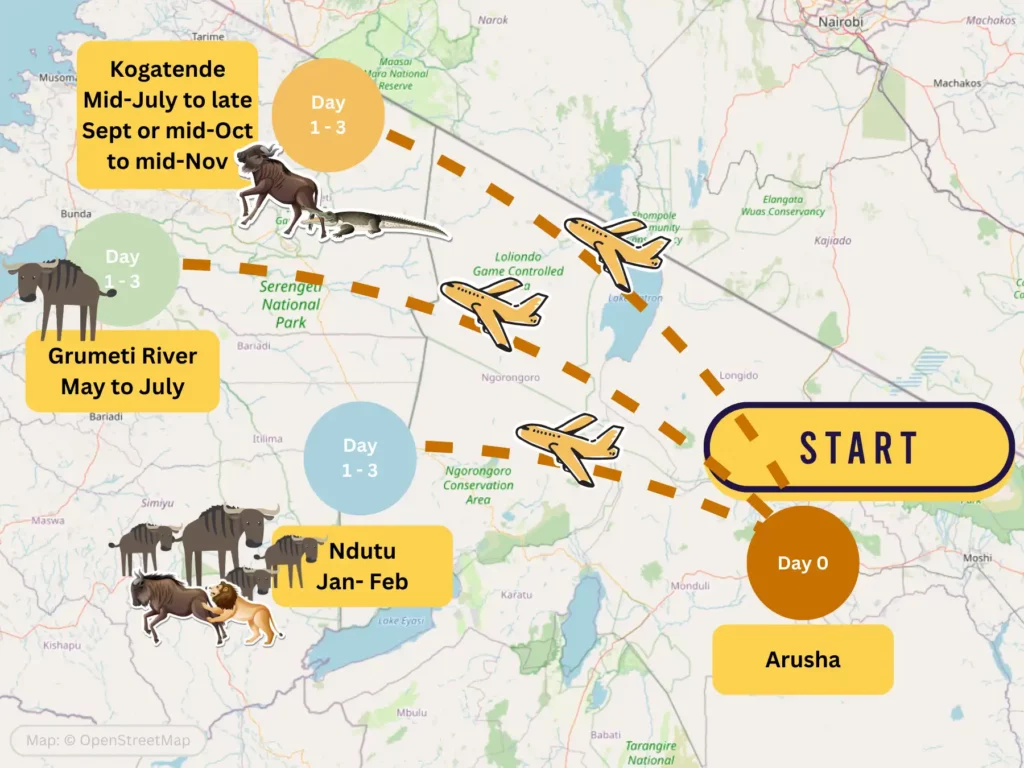
Day By Day Breakdown for 3 Day Great Migration Wildebeest River Crossing / Calving Safari Itinerary
Day 1 – 3: Serengeti (Part of Serengeti will depend on location of Great Migration) – total drive time: 1 – 1.5 hour flight
From Kilimanjaro International Airport in Arusha, you’ll board a small propeller plane and begin your short 1 – 1.5 hour flight to the location of the Great Migration in the Serengeti. If you’re visiting in January / February to see the Wildebeest calving you could get away with driving to Ndutu which is 5-6 hours each way. However, for a 3 day safari, flying will ensure you spend maximum time on safari. The other locations in the Serengeti all require flights for a 3 day safari.
Your location in the Serengeti will change depending on the time of year as the Great Migration moves location throughout the year.
January and February: Fly to Ndutu Airstrip near Southern Serengeti in the Ngorongoro Conservation area. Driving is also possible but can take around 6 hours each way.
May to July: Fly to Kirawira Airstrip in Serengeti’s western corridor.
Mid-July to late September or mid-October to mid-November: Fly to Kogatende Airstrip in northern Serengeti.
Activities for Your Days in the Serengeti
You’ll spend your days on exhilarating game drives to see the Great Migration action as well as related big cat activity.
You can either return to your accommodation for lunch or your safari company can arrange to bring lunch with you to eat in the park. This can usually be either a cold lunch or hot cooked lunch provided by your accommodation.
About The Great Migration in the Serengeti
The herds of the Great migration follow a circular route starting in January / February on the southern plains where they give birth on the nutrient dense grasses of the Ndutu plains.
From here they make their way to the Serengeti’s western corridor. The herds then make the treacherous crossing of the crocodile infested Grumeti River before continuing north for yet another perilous crossing of the Mara river to the delight of the hungry Nile crocodiles.
On the other side of the Mara river the millions of wildebeests enter the Maasai Mara in Kenya before finally returning back over the Mara River and making their way back to the Ndutu plains in the south which completes their annual cycle.
The migration of 1.5 million blue wildebeests, zebras and other herbivores does not go unnoticed by the Serengeti’s huge predator population.
The hotspots for predator dramatic hunting action tend to be around crossing points such as Mara and Grumeti River as well as during the birthing season the Nduto Planes.
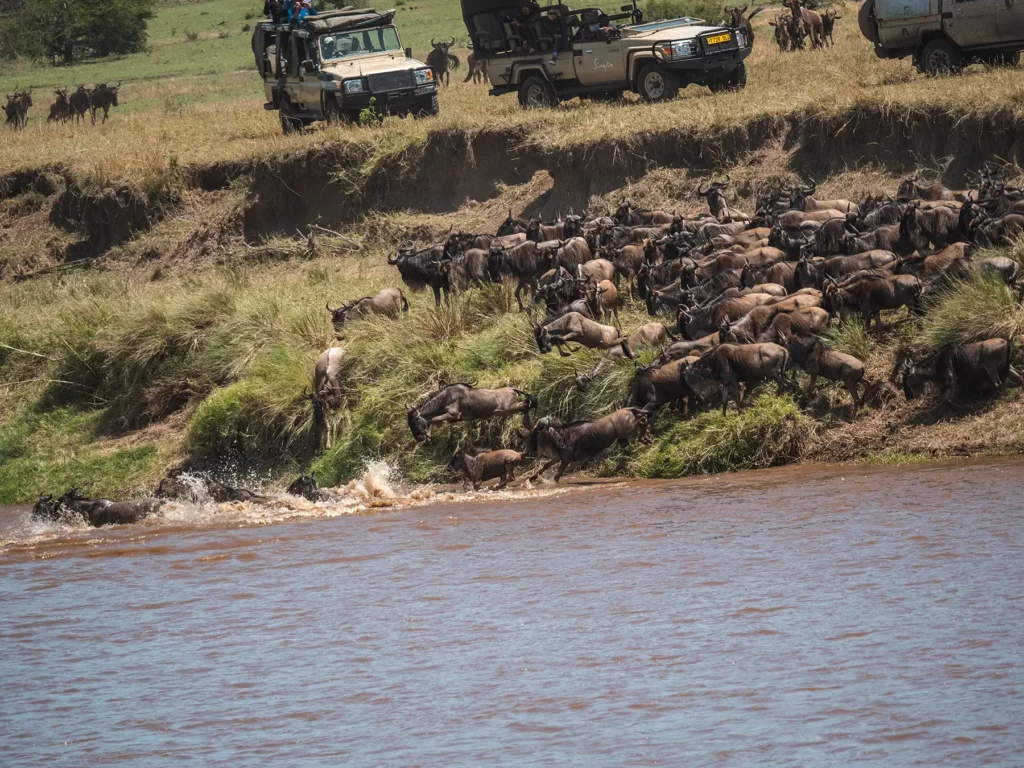
Tips for Visiting the Serengeti for the Great Migration
For the river crossing it’s recommended to allow a couple of days to maximise your chance of seeing the crossing. Sometimes you can be waiting for up to 4 hours from seeing a huge herd of blue wildebeests waiting on the banks of the river to the first brave wildebeest making its way down the banks and jumping into the river. As herd animals, once the first one goes in the river the rest usually follow.
The Ndutu plains, the location of the wildebeest calving is the only park in Tanzania which allows you to drive off the paths in order to get a better sight of the action.
There are mobile tented camps which move around following the great migration – these will give you the closest proximity to the action. Other fixed position camps can be more luxurious but may require slightly more driving each morning to find the herds location.
My Personal Experience of the Great Migration in Serengeti
Although it can sometimes take 4 hours of patiently waiting to witness the epic river crossing, I was very lucky and managed to see two river crossings within an hour of reaching the Mara River.
At the first crossing the crocodiles seemed to be preserving their energy and simply watched as the Wildebeests herds jumped into the water and scrambled up the other side.
However, at the second crossing there was a young wildebeest who seemed to be struggling to get up the steep banks at the other side and decided to turn around to try to retrace his steps to the other bank.
Exhausted after failing to get out of the water at the other bank, a crocodile who had been patiently watching disappeared under the water and suddenly emerged next to the unfortunate wildebeest and in one foul swoop dragged the wildebeest under the water.
I had mixed feelings – I felt bad for the wildebeest but at the same time the crocodile probably hadn’t eaten for months and needed food to live and reproduce. Predators are an important part of maintaining the balance of the ecosystem. Without predators the prey animal populations become too big for the ecosystem to support.
You can view my video on the wildebeest river crossing here.
Where to Spend the Night
You’ll spend the nights of days 1 and 2 in the Serengeti and then fly back to Arusha at the end of day 3 and either spend the night in Arusha or take a connecting flight to your home country or next holiday destination.
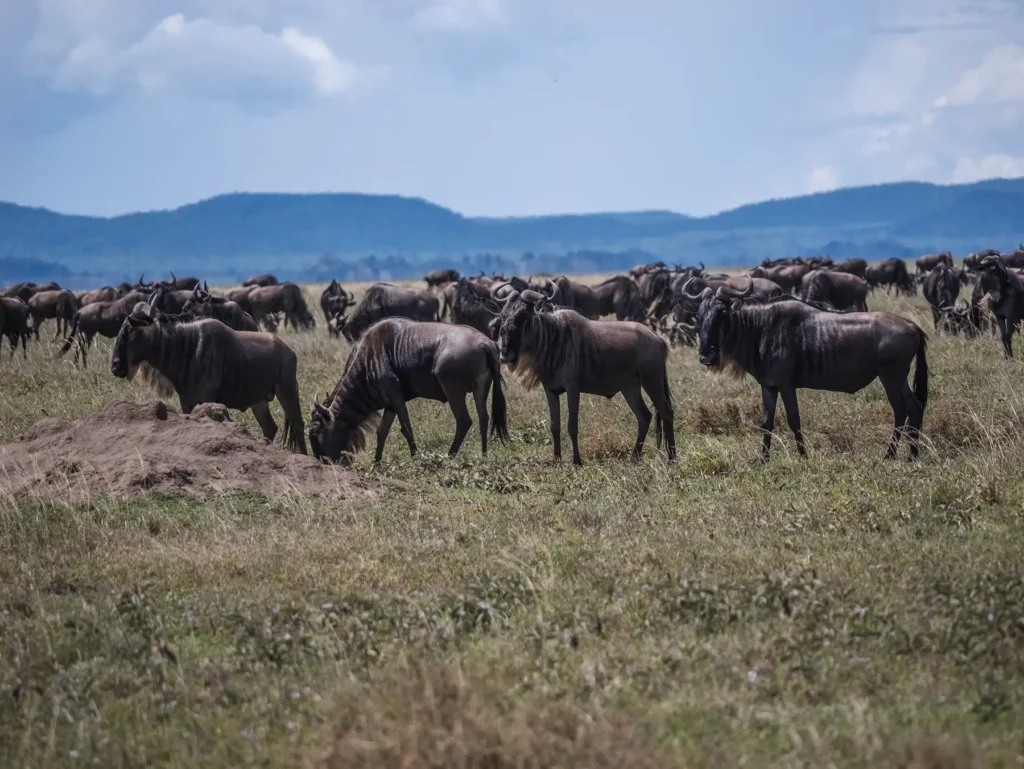
Costs
Compared to the 3-day Serengeti & Ngorongoro Crater fly-in itinerary above, this itinerary is more expensive as it requires return internal flights as well as outbound flights.
- Internal flight between Arusha and Central Serengeti – a guide price for 1 person flying one-way to Seronera Airstrip (Central Serengeti) from Arusha is about $300 and takes around 1 hour.
- Serengeti park fees, which are higher than Tarangire plus Serengeti overnight fees for accommodation in the park.
For this 3-day itinerary, full board Tanzania safari costs for private safaris start at around $600 per person per day for 4 people and $650 for two people. Prices assume working with a small local safari company and will vary depending on the level of accommodation chosen and number of people sharing the safari truck.
Recommended Booking Options For Your 3-Day Great Migration Wildebeest River Crossing / Calving Safari Itinerary
Private Safari
Most popular & best experience – typical prices for this itinerary start from $600 per person per day.
Visit safarisbyella.com for free quotes from trustworthy local tour companies I use to book my own trips.

Group (Shared) Safari – Usually Camping
Good for budget or solo travellers – from $230 per person per day.
My recommended Tanzania tour operators only provide private safaris, however, I’ve listed the best and most similar group options for this itinerary, on SafariBookings below.
No 3-day Group safari options are available for a migration safari. The only group options are 5 days and all involve a 5 - 8 hour drives.
Click the link below to request quotes for the group safari options on the SafariBookings website.
All recommended group results going to Ndutu (for wildebeest calving)
All recommended group results going to Kogatende in Northern Serengeti (for Mara River crossing)
View All My Recomended Group Options Following a Similar Itinerary
Jump back to the table of contents to select another 3 day itinerary to view or keep scrolling to read the next itinerary.
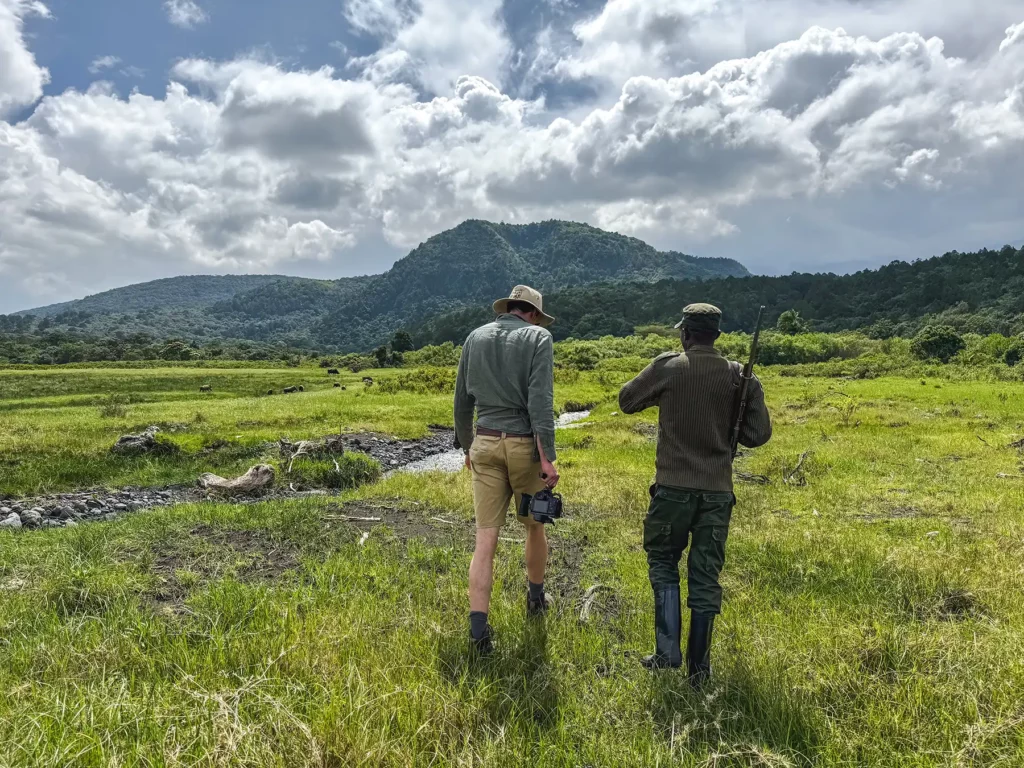
Option 4
3-Day Budget Tanzania Safari Itinerary
One way to have a 3-day budget safari is to opt for a group camping safari. Most of the group camping safaris follow my first 3-day itinerary and can be seen here.
However, if you want to avoid the downsides of a group safari and have the flexibility of a private safari as well as more comfortable accommodation, then my 3-Day Budget Safari Itinerary will give you the best value private Tanzania safari.
You’ll be visiting the lesser known, amazing value Arusha National Park, the world-class and great value Tarangire National Park, home of the huge elephant herds and finally the equally great value Lake Manyara National park.
You could also easily spend two days in Tarangire but the accommodation in the park is quite expensive which is why you’re staying near Lake Manyara.
When creating this itinerary, I was torn between the itinerary I’ve made and an alternative which is Tarangire and then Lake Natron National park (a soda lake which has the ability to turn animals to stone) which would take 3 days in total.
In the end I opted for the current itinerary as it gives you the most wildlife viewing and works at most times of the year.
Lake Natron on the other hand can be difficult to visit in the rainy season as I found out myself when a flooded road made my visit impossible. Although Lake Natron has fewer animals, you can still see flocks of less and greater flamingos, giraffes, kudu, oryx, zebras and ostriches.
If you do decide to try my alternative Lake Natron itinerary, bear in mind that it’s at its best between August and October. I’ve included a group safari with the Lake Natron itinerary.
Quick Facts
- Average driving time per day: 2.8 hours.
- Best times of year: Long dry season from June to October or the short dry season from January to February.
Itinerary Map for the Budget Tanzania Safari Itinerary
Itinerary starts and ends in Arusha.
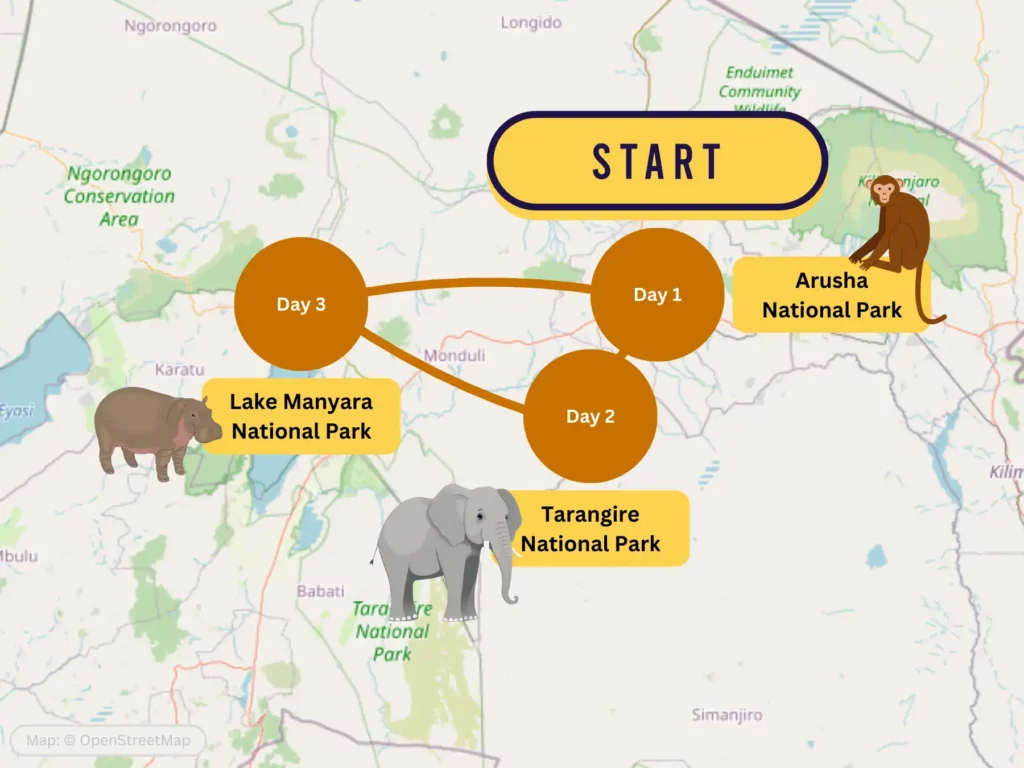
Day By Day Breakdown for the Budget Tanzania Safari Itinerary
Day 1: Arusha National Park – total drive time 2 hrs
Arusha National Park is a hidden gem and hardly features on any of the standard safari itineraries. However, it’s just as good if not better than the much better known Manyara National Park. I only found out about it by talking to one of my guides and decided I’d included it in my next visit – which I did.
The park is fantastic value and it only takes around 1 hour to reach Arusha National Park from the centre of Arusha. Sure, It doesn’t have the same density of predators as much more expensive and comparatively remote parks such as Serengeti or Ngorongoro Crater but unlike those two it does allow walking safaris and features some great wildlife including its famous black-and-white colobus monkeys.
Activities for Your Day in Arusha National Park
You’ll start by driving through the park to the other end.
At the other end of the park, you’ll have the option for a walking safari which I’d fully recommend. It takes around 2 hours. You also have the option of canoeing on small Momella Lake or horse riding.
You’ll then spend the rest of the day on a game drive around the park.
About Arusha National Park
Arusha National Park was established in 1960 and lies to the north east of the city of Arusha.
The park incorporates Mount Meru, an impressive volcano and popular hiking route. It usually takes 4 days to reach the 4,566m summit although it is possible to complete the hike in 3 days.
Arusha National Park is relatively small, covering 552 km² yet boasts the largest population of giraffes in the world and an incredibly varied ecosystems.
The park boasts a large number of colobus and blue monkeys which can’t be seen in the other Northern Circuit parks.
Within the park, there is a mini version of the renowned Ngorongoro Crater known as Ngurdoto Crater. This smaller crater is home to buffaloes and elephants.
There is also a mini version of the Serengeti known as Serengeti Ndogu (little Serengeti) which is a great walking safari destination as well as the forests including Tululusia Hil.
There are 7 shallow alkaline lakes known as the Momella Lakes in Arusha National Park, The most well known being big Momella and small Momella. The other 5 lesser known lakes are: El Kekhotoito, Kusare, Rishateni, Lekandiro and Tulusia.
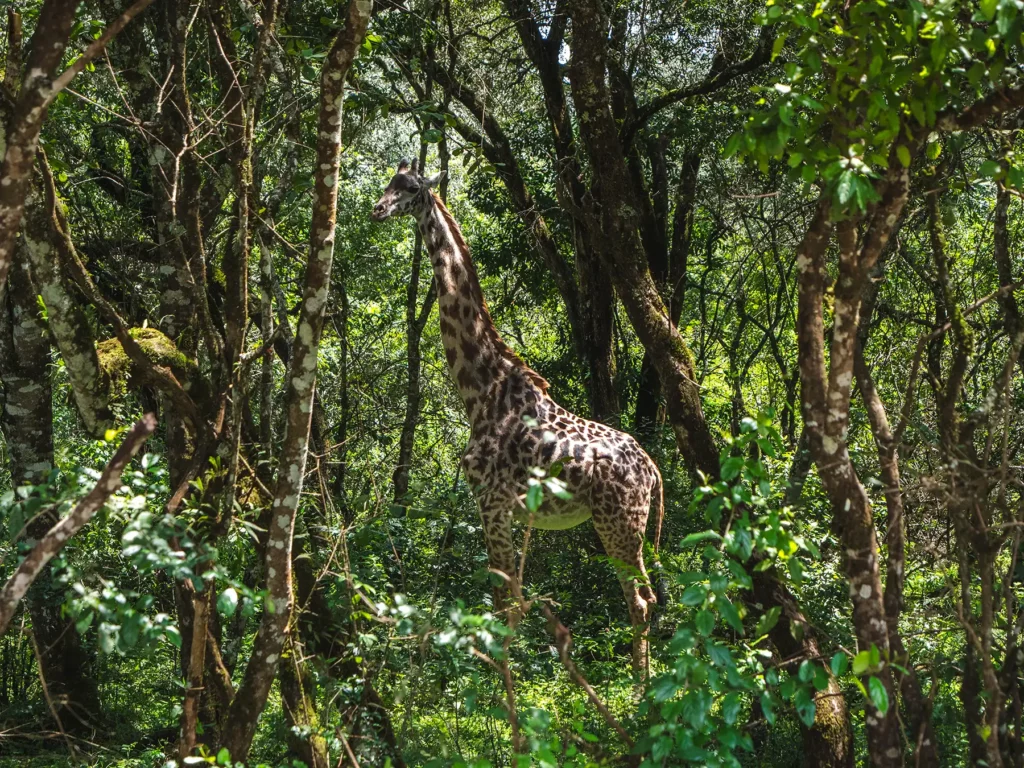
Tips for Visiting Arusha National Park
You can walk to Tululusia Hill, a former lookout dating back to Tanzania’s tribal wars which provides incredible 360 degree views.
If you’re planning on going on the walking safari, wear some good walking boots and bring plenty of water in a backpack. Wear sunscreen and a cap or sunhat. It’s also good to give the walking guide a small tip – around 5 USD should be sufficient for a group of 2 people.
Only eat at designated picnic areas and do not feed the monkey as this causes them to become pests.
Where to Spend the Night
As this is a budget safari, I’d recommend spending the night in Arusha as it has some very cost-effective accommodation. You can then drive to Tarangire tomorrow. Tarangire on the other hand had mostly mid-range and luxury accommodation.
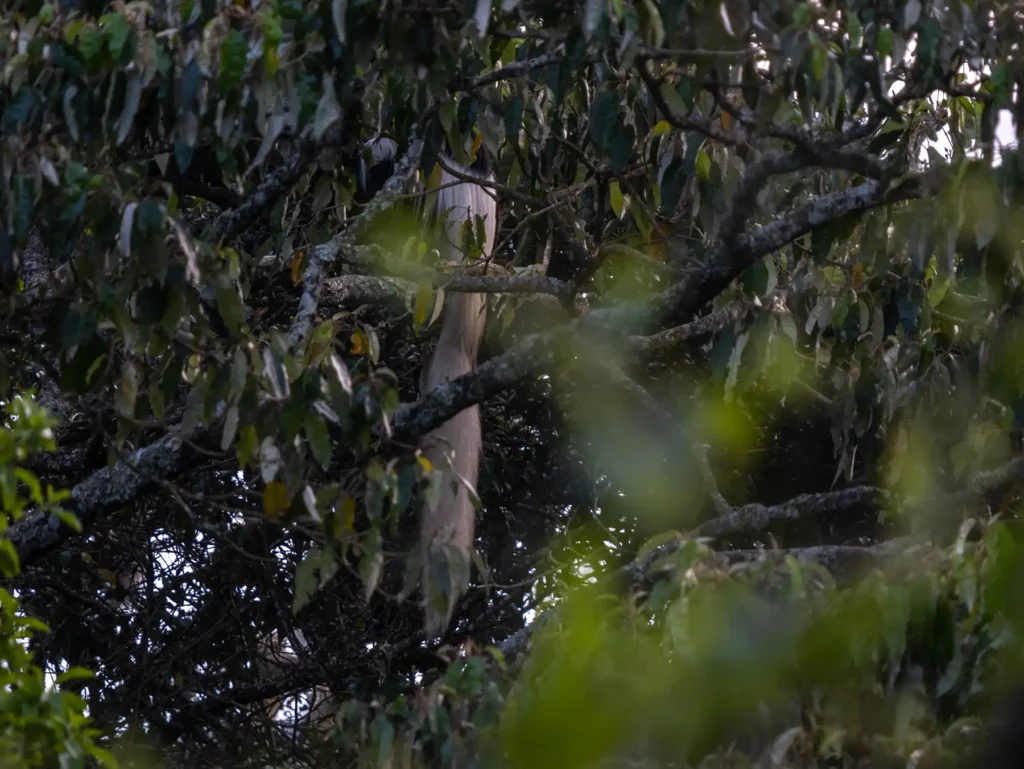
Day 3: Tarangire – total drive time 4 hrs
Tarangire is both great value whilst being a world-class National Park boasting huge herds of elephants.
The only catch (for a budget safari) is that accommodation in the area is quite expensive (mostly mid-range and luxury). However, we’re going to overcome that hurdle with this itinerary by spending the night before in Arusha and the night of the Tarangire safari in Mto Wa Mbu, which sets you up nicely for your Lake Manyara safari the following day.
It takes around 3 hours to drive west from Arusha to Tarangire National Park’s Northern Gate.
Activities for Your Day in Tarangire National park
You’ll go on a full day game drive around the park. You also have the option of a walking safari if you want an even more intimate experience.
About Tarangire National Park
Covering 2,850 km², Tarangire ranks as Tanzania’s 6th biggest park and is one of the jewels of Tanzania’s northern safari circuit.
The park, which was established in 1970, gets its name from the Tarangire River which flows through the middle of the park and provides a much needed source of water in Tanzania’s dry season.
The park is most famous for its herds of African elephants which can total over 5,000 during the peak of the migration from July to October.
Predators including lions are a common sight in the park.
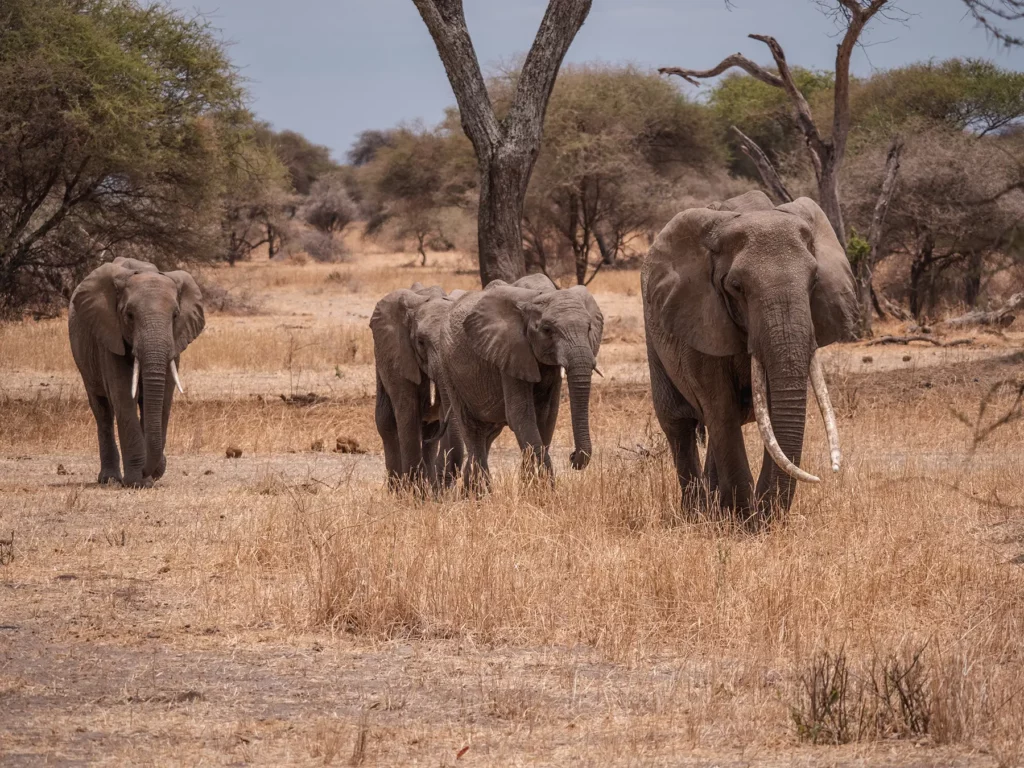
Tips for Visiting Tarangire
The best time to visit Tarangire is in the dry season when the migratory herds are present.
Ensure that your safari company brings a hot to cold lunch for you to enjoy at one of the fantastic lunch spots in the park as these are un-catered.
My Personal Experience in Tarangire
I didn’t have many expectations of Tarangire as it wasn’t a place I had heard much about prior to visiting. However, the park quickly earned its place as one of my favourites in Tanzania. The landscape itself is breathtaking, long grass stalks lapping at the legs of elephants and giraffes in between baobab trees of all kinds of shapes and sizes.
The highlight however was the elephants. I was left in awe as an entire family crossed the road right in front of us and made their way down to a watering hole. Watching the elephants throw water over themselves in contentment was a magical sight. I particularly loved watching a young calf roll around in the water, seemingly having the time of its life.
Tarangire is more than just elephants, as I quickly found out. I saw lots of giraffes, the largest troop of baboons that I’d ever seen and some lions resting in the shade.
You can watch a video of my Tarangire safari experience on Youtube.
Where to Spend the Night
You’ll drive for around 1 hour to Mto Wa Mbu, where you’ll spend the night. This sets you up nicely for your Lake Manyara safari the following day.
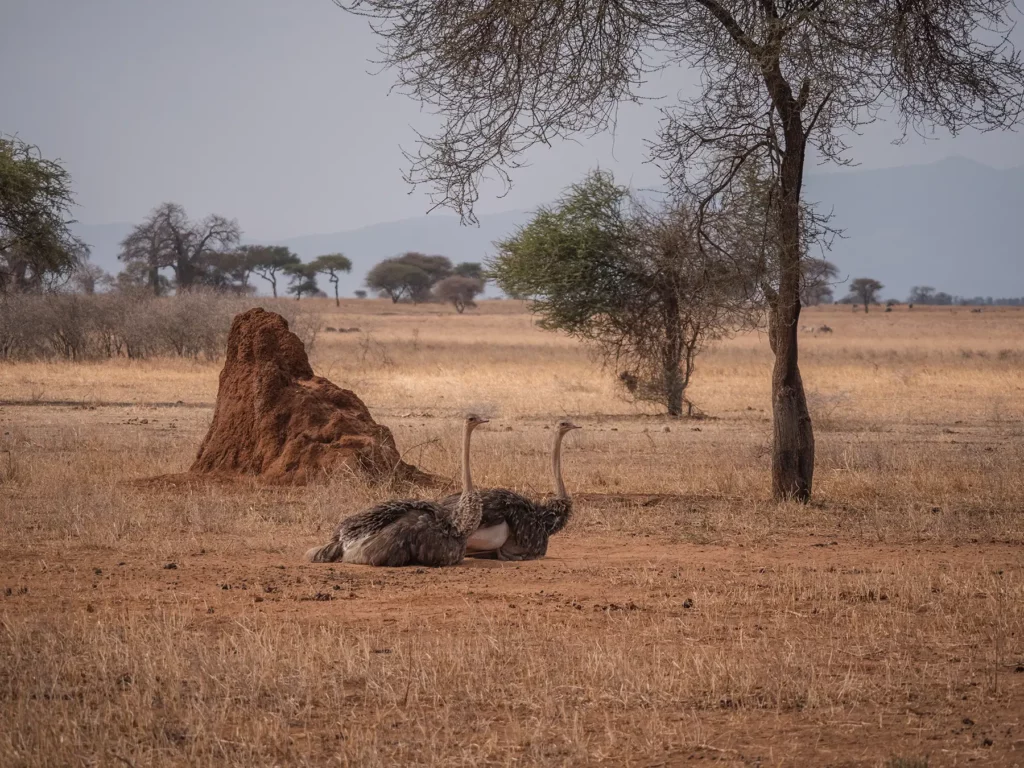
Day 3: Lake Manyara National Park (total drive time 2.5 hrs)
Lake Manyara National Park is a popular and great value park on Tanzania’s northern circuit. The entrance to the park is only a short 30 minute drive from the town of Mto Wa Mbu.
Mto Wa Mbu is Swahili for river of mosquitos so it goes without saying pop some mosquito repellent on , especially when in the town. Although I picked up a few bites at first as soon as I put my repellant on I didn’t get a single bite.
Activities for Your Day in Lake Manyara National Park
You’ll spend the morning on a game drive around the park – this is usually enough time to cover the whole park.
Afterwards you have a few options or you could potentially squeeze them all in!
If you fancy a walking safari from the tree tops, there is a 45 minute treetop canopy walk.
See the park from the make with a canoeing safari on lake Manyara (subject to the water levels being high enough).
Take the opportunity to go on a nighttime safari as this is one of the only parks to allow this.
Visit a Maasai Boma in Mto Wa Mbu to watch their traditional jumping dance and learn more about their customs and way of life. Visits usually take around an hour unless you want to stay longer such as for a nighttime fire or goat bbq.
About Lake Manyara National Park
Lake Manyara was given National Park status in 1960 to protect the vast elephant herds which stroll through the park.
The park is famous for its tree-climbing lions and huge flocks of pink flamingos as well as 250 other bird species.
Visiting the park provides a great experience due to the diverse landscape with dense forests, steep mountainsides and a massive yet shallow soda lake which covers two thirds of the 325 km2 (125 mi2) park.
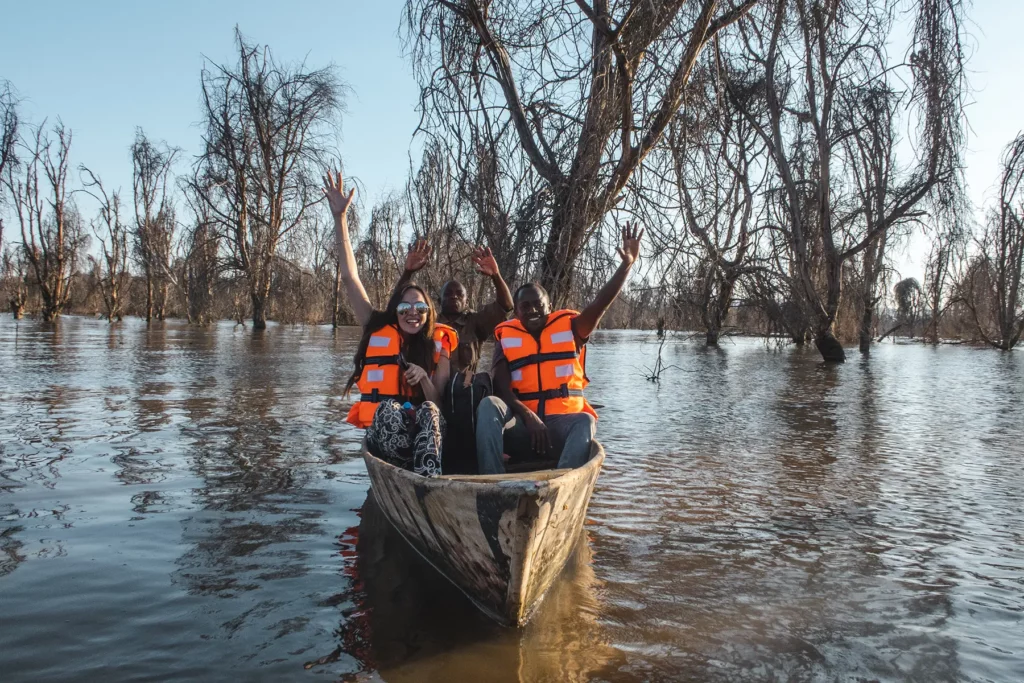
Tips for Visiting Lake Manyara National Park
Lake Manyara National Park is great to visit all year round. However, the very best time to visit for wildlife spotting is during the long dry season from June to October. As with other parks, it becomes very beautiful during the rains when the vegetation is lush and waterfalls are full. However, wildlife spotting is harder at these times due to the dense vegetation making spotting harder.
My Personal Experience in Lake Manyara National Park
I went on a canoeing safari in Lake Manyara with local fishermen, in locally-built canoes made from fig trees. The bellows of hippos echo through the forest of half-submerged trees, a reminder that the park had suffered in recent years as a result of too much rain. Vast swathes of forest were taken by the rising lake levels but I believe it is now gradually receding.
I saw vervet monkeys playing on the banks of the lake and in the distance I saw a herd of cows making their way through the forest, accompanied by a Maasai herder. The sound of cowbells filled the air. Whilst the Maasai cannot graze their cattle within the national park, they do take them to the edges of the park, such as here.
You can watch a video of my Lake Manyara canoe safari & Mto Wa Mbu tour on YouTube.
Where to Spend the Night
You’ll spend the night back in Arusha which is around a 2 hour drive.
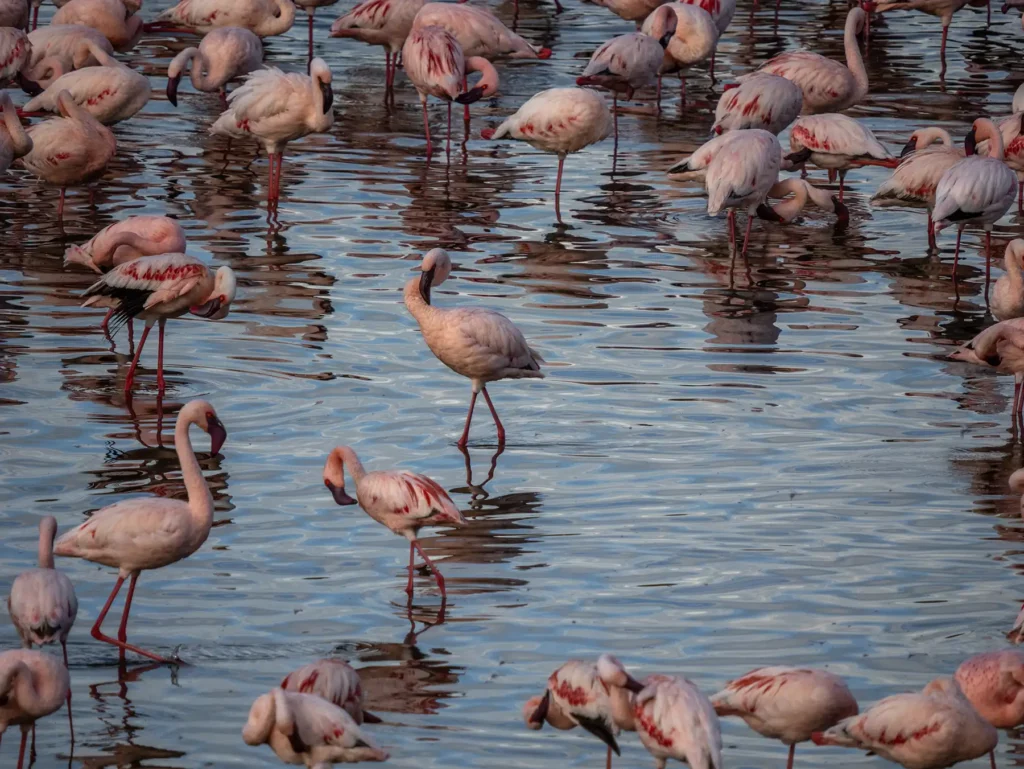
Costs
For this 3-day itinerary, full board Tanzania safari costs for private safaris start at around $280 per person per day for 4 people and $270 for two people. Prices assume working with a small local safari company and will vary depending on the level of accommodation chosen and number of people sharing the safari truck.
Recommended Booking Options For Your 3-Day Budget Safari Itinerary
Private Safari
Most popular & best experience – typical prices for this itinerary start from $280 per person per day.
Visit safarisbyella.com for free quotes from trustworthy local tour companies I use to book my own trips.

Jump back to the table of contents to select another 3 day itinerary to view or keep scrolling to read the next itinerary.
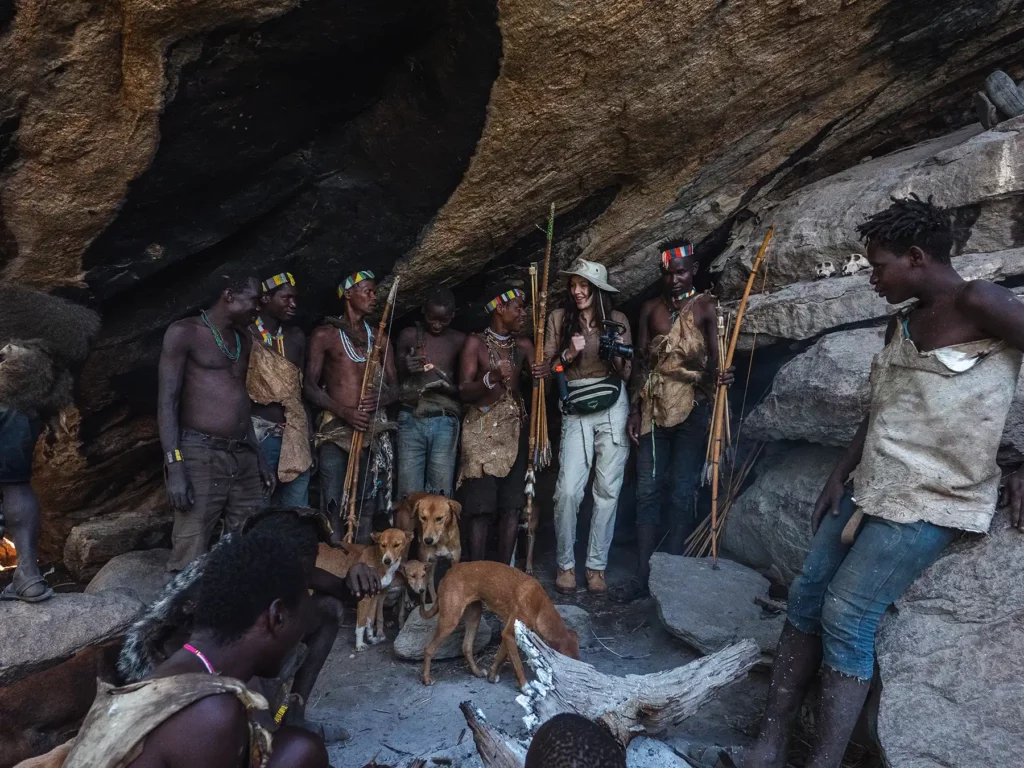
Option 5
3-Day Tanzania Cultural Tour Itinerary
Although most visitors come to Tanzania to go on safari in its world-class national parks, its culture is just as incredible.
The country boasts over 120 incredible tribes, each with their own unique customs and traditions. Some of my peak experiences in Tanzania have involved spending time with tribes including the Maasai and Hadzabe bushmen.
There is a danger that over time some of these authentic cultural experiences can become more commercialised. For this reason I always make an effort to seek out authentic and ethical experiences with the help of my safari company.
The results have been some of the most memorable and eye opening experiences of my life.
Whilst this itinerary will focus purely on cultural activities, you may wish to mix some of these cultural activities into the other itineraries above. The activities are located near to national parks and many of them can be completed in a few hours after a morning safari.
Quick Facts
- Average driving time per day: 4.6 hours.
- Best times of year: Long dry season from June to October or the short dry season from January to February.
Itinerary Map for the 3-Day Cultural Tour Itinerary
Itinerary starts and ends in Arusha.
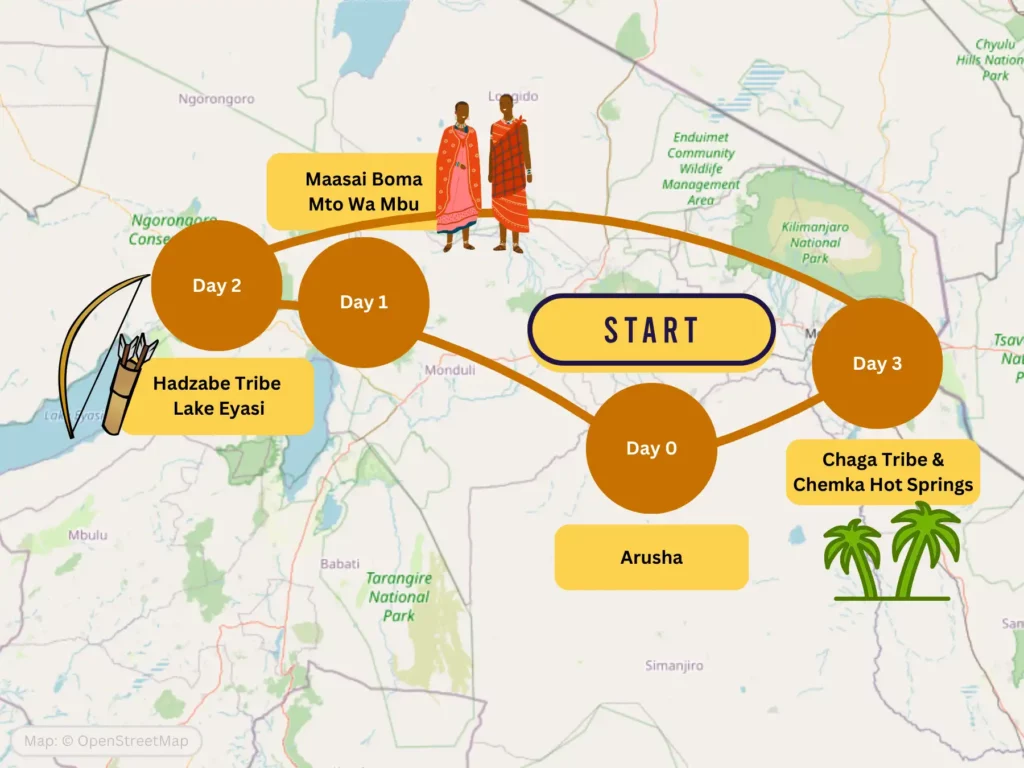
Day By Day Breakdown for the 3-Day Cultural Tour Itinerary
Day 1: Maasai in Mto Wa Mbu – total drive time 3.5 Hrs
From Arusha it’s a 2 hour drive to Mto Wa Mbu, where you can visit a Maasai Boma. The Maasai are Tanzania’s most famous tribe and very welcoming.
Activities for Your Day The Maasai in Mto Wa Mbu
You can spend anywhere from an hour up to a whole day with the Massai tribe. When you visit the Maasai, they will usually put on their traditional jumping dance where the men of the village try to jump the highest to show their strength and to attract a wife.
You can even spend the evening by joining the tribe for a traditional goat bbq. If you’ve really adventurous you can spend the night with some of the Maasai tribes and try out living in their traditional nomadic huts.
Other local activities include:
A cultural tour through the banana plantations and rice paddies in Mto Wa Mbu (Swahili for ‘river of mosquitos’)
A canoe safari in Lake Manyara (subject to the water being high enough)
A 45 minute tree top canopy walk in Lake Manyara National Park.
About The Maasai in Mto Wa Mbu
The Maasai tribe are fearsome warriors known as the cowboys of Tanzania due to their nomadic lifestyle tending to the cattle.
The word Maasai comes from Maa speaking Sai people.
For Maasai cows are sacred and their lives revolve around their cows. Their cows are everything to them. Cows are food, money, status, medicine and even a gift to the father of the bride when getting married.
The Maasai are poly monogamous meaning they have multiple wives. Try to keep an open mind as you learn about their culture as it is fascinating and quite different from our Western culture.
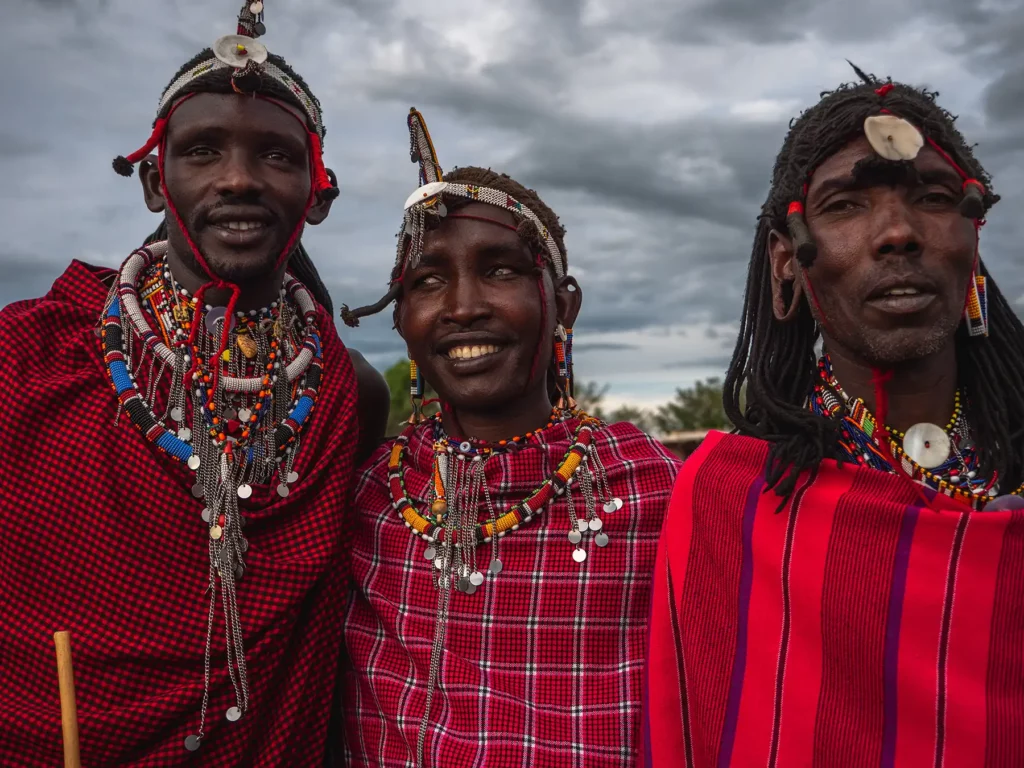
Tips for visiting Maasai in Mto Wa Mbu
Whilst most Maasai visits provide an authentic experience, there are some which have become a bit overly commercialised – usually those on the main roads which have a very high volume of visitors. Choosing a good safari company and also letting them know you want see a slightly more remote Maasai Bom for an authentic experience will help ensure you have the most authentic and unique experience.
Reputable safari companies will have already given the Maasai boma you are visiting a monetary contribution as a thank you for hosting you so don’t feel obliged to give more than a small tip. I would suggest around $10 as a tip for two visitors or a little more if it was a half day or full day experience. Remember than money goes a lot further for locals in Tanzania compared to the West.
Alternatively, instead of providing a tip, you can simply buy some jewellery made by the tribe. Its perfectly normal to negotiate on price. I normally pay around $6 – $15 for a metal bracelets where negotiation may start as high as $30. To negotiate you can simply set your price you’re prepared to pay and then walk away if it’s not met – they will usually agree to your price or give you a counter offer slightly higher. I probably always end up paying a bit more than I could probably get them for but I try to be fair in my negotiations as they do reply on income from tourism.
My Personal Experience of visiting the Maasai in Mto Wa Mbu
I’ve visited a couple of different Maasai bomas in the area. On each occasion that I visit, the Maasai put on a beautiful display of song and dance followed by some traditional Maasai jumping. The higher a Maasai warrior can jump, the more desirable he is.
For one of my visits, I decided to veer away from the traditional experience that most tourists get and spent an entire morning with a Maasai family. I watched as they prepared a traditional Maasai meal – boiled goat. It was an experience that I’ll never forget as I got to see the entire process, start (when the goat was alive and walking) to finish. You can have a similar experience if you request it with your safari company beforehand.
You can see my video of my immersive Maasai tribe experience here.
Where to Spend the Night
You’ll drive for around 1 – 1.5 hours to spend the night in Lake Eyasi, ready for an early start visiting the Hadzabe in the morning.
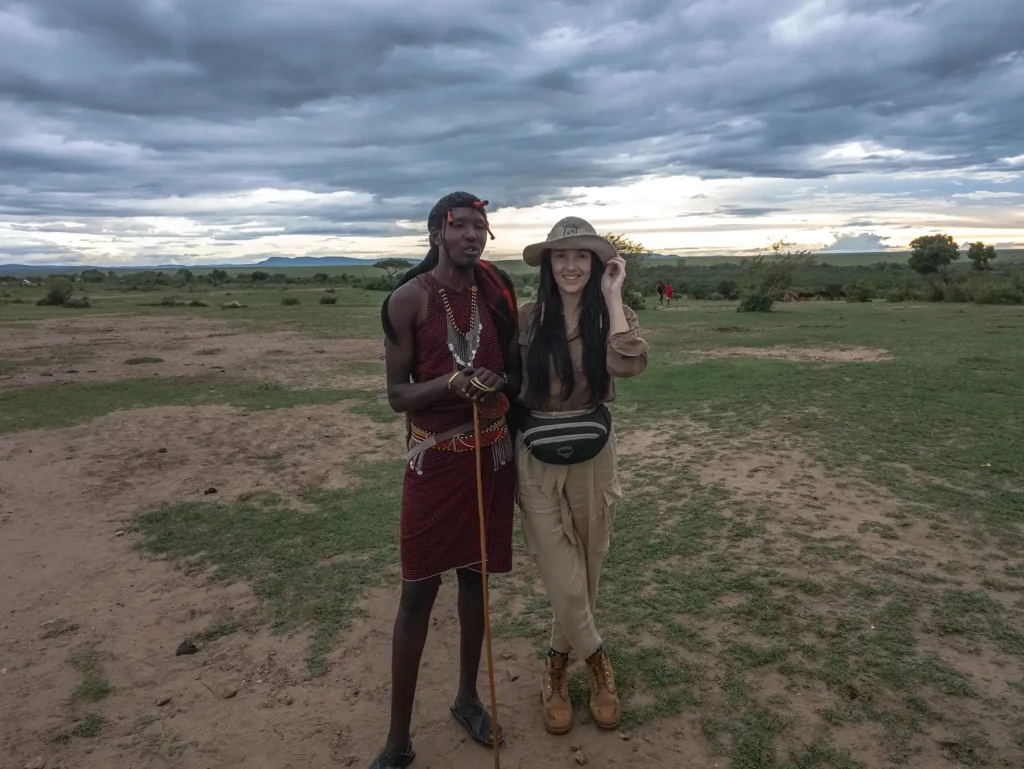
Day 2: Hadzabe Bushmen & Datoga in Lake Eyasi – total drive time 4
Visiting the the Hadzabe bushmen was one of the most authentic cultural experiences I’ve had in my travels. Uninterested in money and the trappings of modern life the Hadzabe life, they share everything.
This is one of the last opportunities in the world to step back in time to see how our hunter gather ancestors lived thousands of years ago.
From you accommodation in Lake Eyasi it can take around an hours drive for your hadzabe guide to locate the Hadzabe.
Activities for Your Day Visiting the Hadzabe Bushmen & Datoga Tribes
You can visit the remote Hadzabe village made up of tiny bare nomadic huts or sometimes they live in caves in the rainy seasons. You will have the opportunity to go on a small hunt with the tribe where they will show you have they catch their food with bows and arrows. They are fast walkers so you need to be physically fit to keep up.
In the afternoon you’ll visit the nearby Datoga (aka Datooga or blacksmiths) tribe and watch them make jewelary and tools such as arrow heads from scrap metal.
About the Hadzabe Bushmen & Datoga Tribes
The Hadzabe bushmen have lived in the Lake Eyasi basin for around 5,000 years and in this time their way of life has changed very little.
They live a simple life hunting and gathering all their food. They get their water from the roots of plants and share everything with the other members of the tribe.
There are only a small number of Hadzabe left and they only speak in their own unique clicking dialect so your safari company will enlist the help of a special guide who has lived with the Hadzabe and learned to communicate with them. The Hadzabe are nomadic, moving around in search of food, so it can sometimes take a while to locate them in the wilderness around Lake Eyasi.
The Datoga aka Datooga, (Wamang’ati, in Swahili), who live nearby, moved from their first home in southern Sudan and the highlands of western Ethiopia to the Lake Eyasi area about 3,000 years ago.
In the past, the Datoga tribe used to be nomads, always on the move to find food for their cattle, goats, and sheep. But now, they have decided to live in one place and set up small villages made up of around 5 wooden huts. In these villages, they’ve become really good at making things with metal, like arrowheads and jewellery. The tribe trade these items with other tribes, such as the Hadzabe.
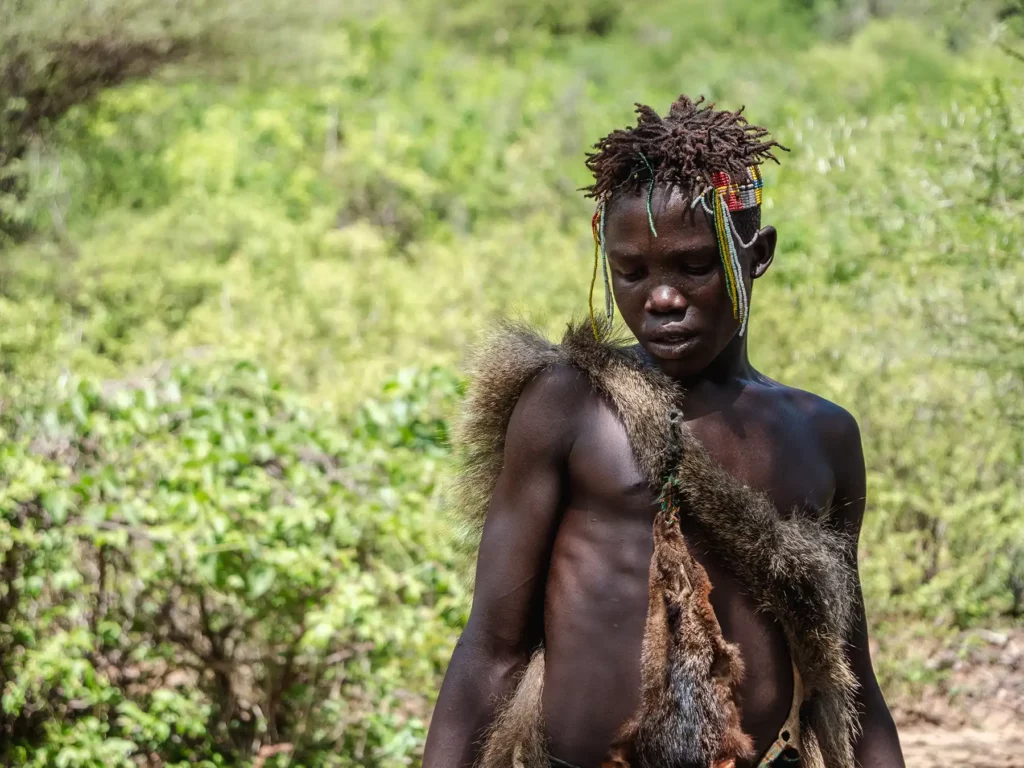
Tips for Visiting the Hadzabe Bushmen & Datoga Tribes
Stay open-minded when visiting the Hadzabe as they live a very different life to what we’re used to in the west.
Although at first you might find it shocking to see them hunting animals with bows and arrows such as small birds, remember that in the West, most of us still eat meat, we’re just much less connected with where that meat comes from.
The Hadzabe only hunt and gather what they need to survive, nothing is wasted. For example, the tendons of the animals the eat are used as string for their bows.
I bought some metal bracelets from the Datoga tribe=, spending around $35 per bracelet. You could probably negotiate them down to around $15 each if buying a few of them but $35 is similar to what I’d pay in the UK so I didn’t bother.
My Personal Experience Visiting the Hadzabe Bushmen & Datoga Tribes
Visiting the Hadzabe tribe had been on my bucket-list ever since I saw them in a documentary. But I didn’t just want to go on a typical visit, where you only briefly meet and interact with the tribe. I wanted to see how they lived – what a typical day was like for them.
I’ve visited the Hadzabe tribe a couple of times now and been on several hunts with them. They go on a long hunt early in the morning, around 6:30am and the hunt lasts for as long as it takes to catch enough to feed the tribe.
My first hunt with the Hadzabe was in the dry season. We walked swiftly across dry river beds and down well-worn trails. The tribe caught three birds, a mouse, a dik-dik and a white-tailed mongoose. The hunt was a huge success! I then watched as they prepared the meat and was even offered to try some dik-dik heart and liver – it was delicious!
You can view my video on this Hadzabe experience here.
My second hunt was in the short rainy season and was a completely different experience. Due to the rains, the tribe had moved to a cave atop a rocky hillock that was surrounded by other hills. The hunt took us up and down steep rocky hills, meandering through thickets of acacia trees with terribly sharp thorns. The rough terrain meant it was slow going and the hunt dragged onto the afternoon. I foolishly brought only one bottle of water with me, which ran out after a couple of hours. Under the heat of the midday sun, I became pretty dehydrated. Finally, they caught what they had been tracking all morning, a huge bush pig.
My experience with the Datoga tribe was vastly different. The Datoga are herders and more uniquely, blacksmiths. After being given a tour of one of their houses, I watched two Datoga tribesmen make arrowheads from recycled metals. These arrowheads will be sold to the Hadzabe tribe.
You can view my video of my time with the Datoga here.
Where to Spend the Night
You’ll drive back to Arusha for the night which will take around 3 hours.
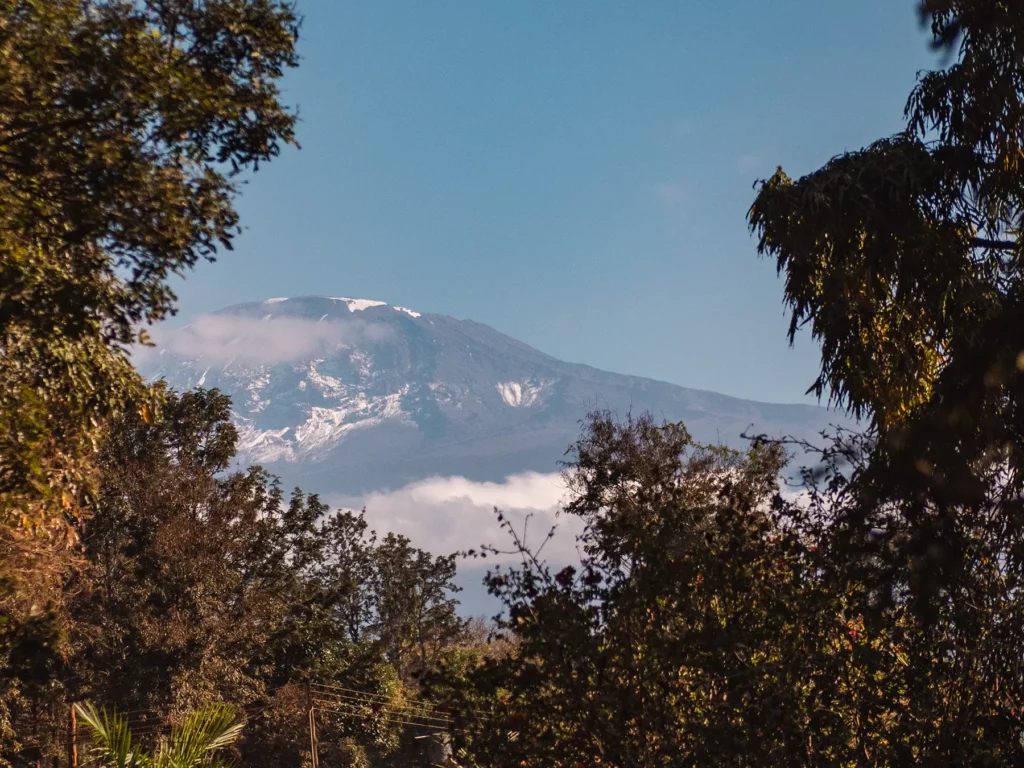
Day 3: Chaga Tribe on Kilimanjaro & Chemka Hot Springs (total drive time 6.5 hrs)
From Arusha you’ll drive for around 3 hours to Materuni village in the foothills of Kilimanjaro and home to the Chaga tribe.
In the afternoon you finish your tour with a relaxing visit to the Chemka Hot Springs.
Activities for Your Day Visiting the Chaga Tribe & Chemka Hot Springs
From Materuni village, it’s a not-too-hard 45-minute walk to the amazing Materuni Waterfalls. You can take a swim there if you want, but be ready for cold water. If you prefer, you can also drive closer, and then it’s only a 15-minute walk.
Back at Materuni village you’ll spend time with the Chagga people and will cook you a delicious traditional lunch.
After lunch you’ll learn more about how they villagers grow and harvest coffee on the banks of Kilimanjaro. You’ll be invited to take part in the process of preparing and roasting the coffee beans by hand before finally tasting the amazing fresh coffee.
In the afternoon you’ll go on a 1 – 2 hour drive down to the Chemka Hot Springs for a relaxing afternoon floating or swimming in the springs.
About the Chaga Tribe & Chemka Hot Springs
The Chaga tribe are descendants of immigrants of various Bantu tribes who migrated to the once forest-covered foothills of Kilimanjaro around 1,200 years ago.
The tribe are famous for the strong work ethic, growing many crops including coffee on the fertile foothills of Kilimanjaro. Members of the tribe also work as porters carrying sleeping equipment and supplies up and down Kilimanjaro for tourists who hike the mountain.
Chemka Hot Springs are mineral springs which originate from Kilimanjaro ground waters. The water in the hot springs is warm because the water underground gets heated by the Earth’s natural heat, and then it comes up to the surface, making the spring warm.
The hot springs are comprised of two lagoons connected by a narrow channel. The source of the hot springs is a mysterious underground cave in the larger of the two lagoons – you can spot it by the bubbles coming up.
Despite what the name would suggest, the hot springs are actually a rather pleasant at around 20°C.
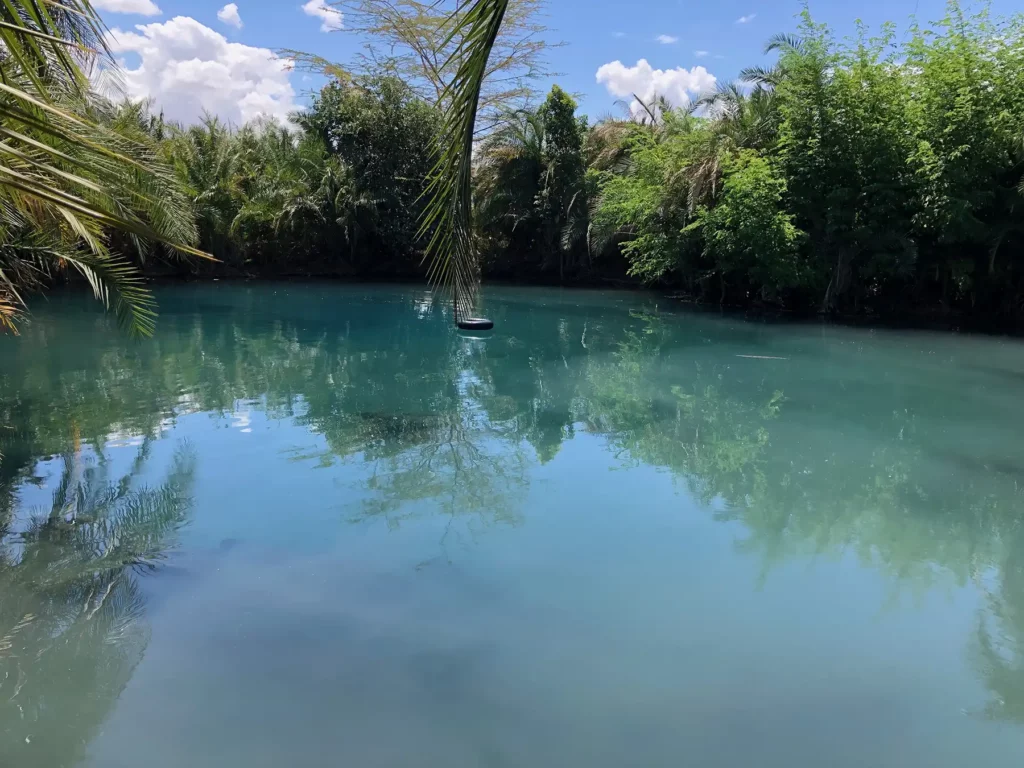
Tips for Visiting the Chaga Tribe & Chemka Hot Springs
For the walk to Materuni Waterfalls, wear good walking boots and be prepared for some mud if there has been rain recently especially in the short and long rains.
The Chemka Hot springs are sometimes referred to as Kikuletwa Springs (Maji Moto).
Take a small amount of cash with you so you have the option of renting a rubber ring which will allow you to float on the on the water.
There is a rope swing into the smaller of the two lagoons which is great fun.
If you can, bring a snorkel mask as it’s very pretty underwater.
There is a fantastic restaurant at the springs which serves traditional food.
My Personal Experience Visiting Chemka Hot Springs
I absolutely loved my visit to Chemka Hot Springs! The springs are a beautiful vibrant turquoise colour which glitters under the sun. I’ve honestly never seen water like it!
I particularly loved the rope swing which you can use to swing into the springs. It was exhilarating and splashing into the springs is extremely refreshing.
I did however expect the springs to be hotter than they were. They’re not cold but they’re certainly not hot. Maybe lukewarm is the best description.
Marvelling at the source of the springs was also a highlight. In the deepest part of the springs it looks like an underwater volcano!
Finally, I had fun at the fish spa. Before my swim I sat with my feet in the water and watched as dozens of tiny fish flocked to nibble at the dead skin. It was ticklish but a fun experience.
You can view my experience at Chemka Hot Springs here.
Where to Spend the Night
You’ll spend the night back in Arusha, which is a 2 hour drive.
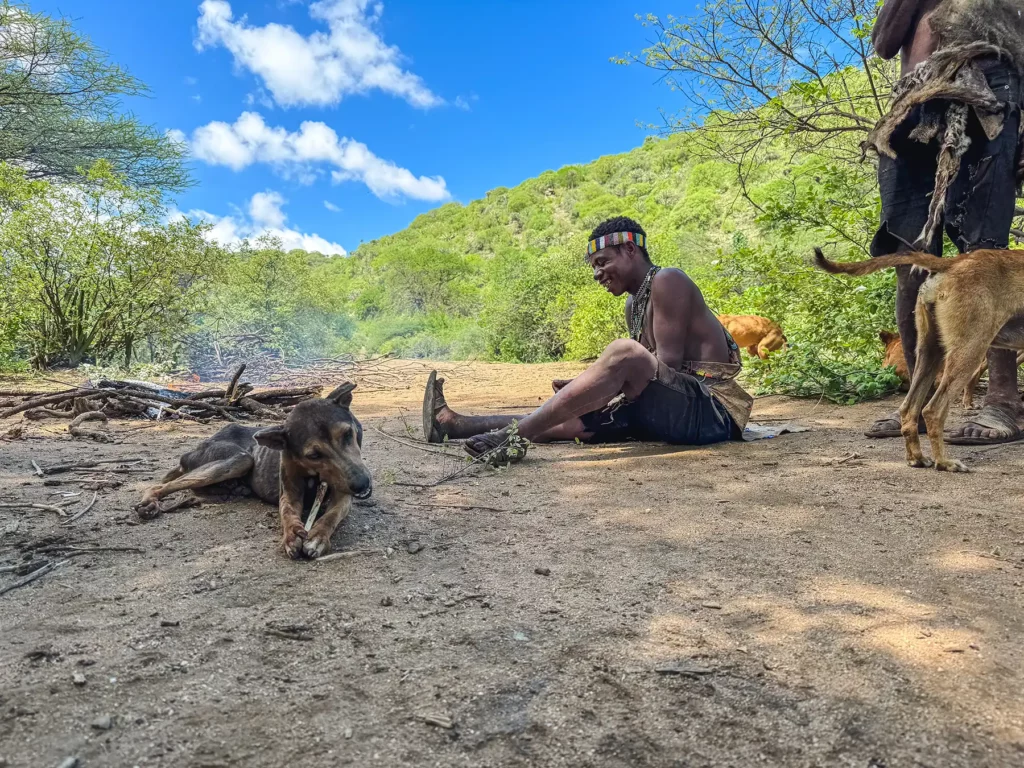
Costs
This cultural tour is around the same cost the the budget safari itinerary but may come out slightly cheaper depending on your exact itinerary. There will be some savings on safari safari fees with this itinerary but this will be balanced out by park fees in Kilimanjaro and Lake Eyasi and your safari company will need to arrange a special Hadzabe guide for your day with the Hadzabe.
For this 3 day itinerary, full board Tanzania safari costs for private safaris start at around $250 per person per day for 4 people and $270 for two people. Prices assume working with a small local safari company and will vary depending on the level of accommodation chosen and number of people sharing the safari truck.
Recommended Booking Options For Your 3-Day Cultural Tour Including Hadzabe Bushmen Itinerary
Private Safari
Most popular & best experience – typical prices for this itinerary start from $280 per person per day.
Visit safarisbyella.com for free quotes from trustworthy local tour companies I use to book my own trips.

Group (Shared) Safari – Usually Camping
Good for budget or solo travellers – from $348 per person per day.
My recommended Tanzania tour operators only provide private safaris, however, I’ve listed the best and most similar group options for this itinerary, on SafariBookings below.
No 3-day Group tours following this exact itinerary, so I've listed the most similar options. Prices for group tours are actually coming out higher than a private tour.
Click the link below to request quotes for the group safari options on the SafariBookings website.
3-Day Budget Lodges Group Wildlife and Cultural Experience
4-Day Budget Lodges Group Wildlife and Hadzabe Cultural Experience
View All My Recomended Group Options Following a Similar Itinerary
Jump back to the table of contents to select another 3 day itinerary to view or keep scrolling to read the next itinerary.
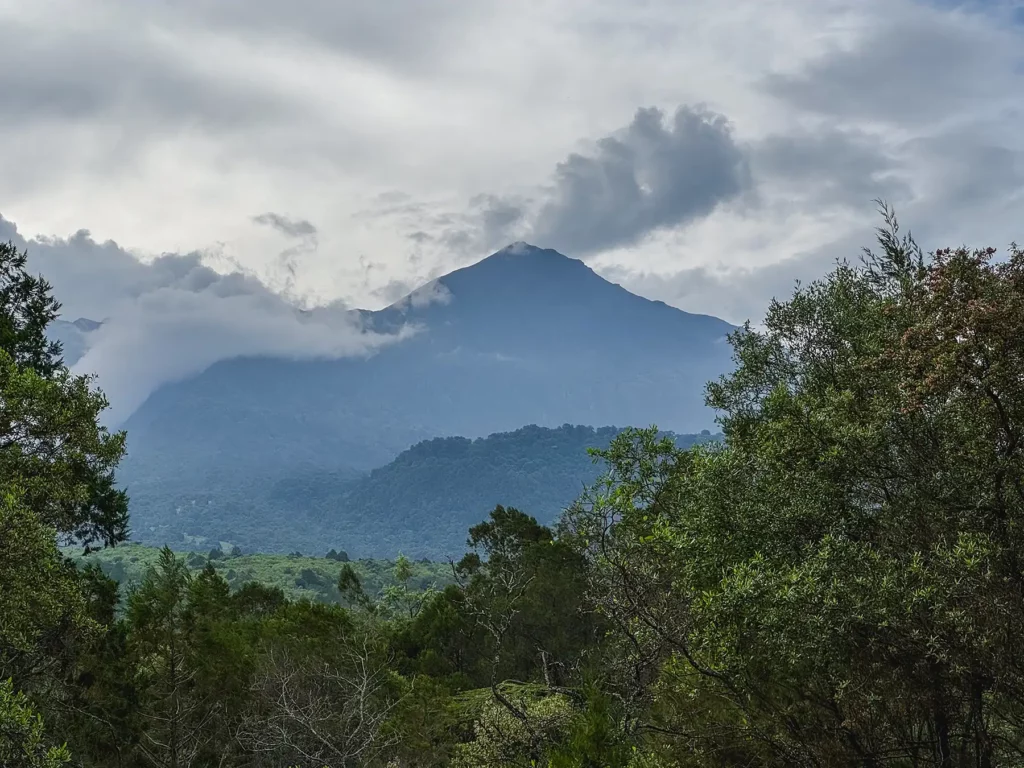
Is 3 Days Enough in Tanzania?
Yes – it’s certainly possible to have an incredible 3 day safari and this is actually a very popular option.
However, If you have time, I would recommend adding a couple of extra days to give you a 5 day Tanzania itinerary. If you have the time you can easily fill out a 7-10 day safari itinerary too.
The main reason a 3 day itinerary can work well in Tanzania is the sheer density of wildlife in the national parks. The high density of animals including predators gives you a good chance of some amazing sightings in a short period of time.
With over 4,000 lions in the Serengeti and connected Maasai Mara ecosystem, Central Serengeti has the highest density of big cats of any national park and is one of the top 5 most important places in Africa for lion conservation.
In many cases you’ll have fantastic sightings within hours of entering a National Park – I was lucky enough to see a magnificent leopard, lazing in a tree within 15 minutes of entering the Serengeti on my most recent visit.
However, wildlife can be unpredictable and the longer you spend on safari the greater your chances of incredible sightings.
By contrast in other national parks such as Ranthambore National Park in India, you might have to wait days to see their most famous inhabitant, the bengal tiger.
Another reason the 3 day safari works well in Tanzania is the number of airstrips which gives you the option to quickly fly to the various parts of the best national parks such as the Serengeti, which would otherwise be an 8 hour drive from Arusha.
Alternatively, If you’d prefer to travel exclusively by road, you have a great option of incorporating Tarangire, Ngorongoro Crater and Lake Manyara National Parks in a 3 Day Multi-Park Northern Circuit Itinerary.
It’s popular to incorporate a 3 day safari into a 5 day safari and beach itinerary with 3 days of safari followed by 2 days of beach in Zanzibar.
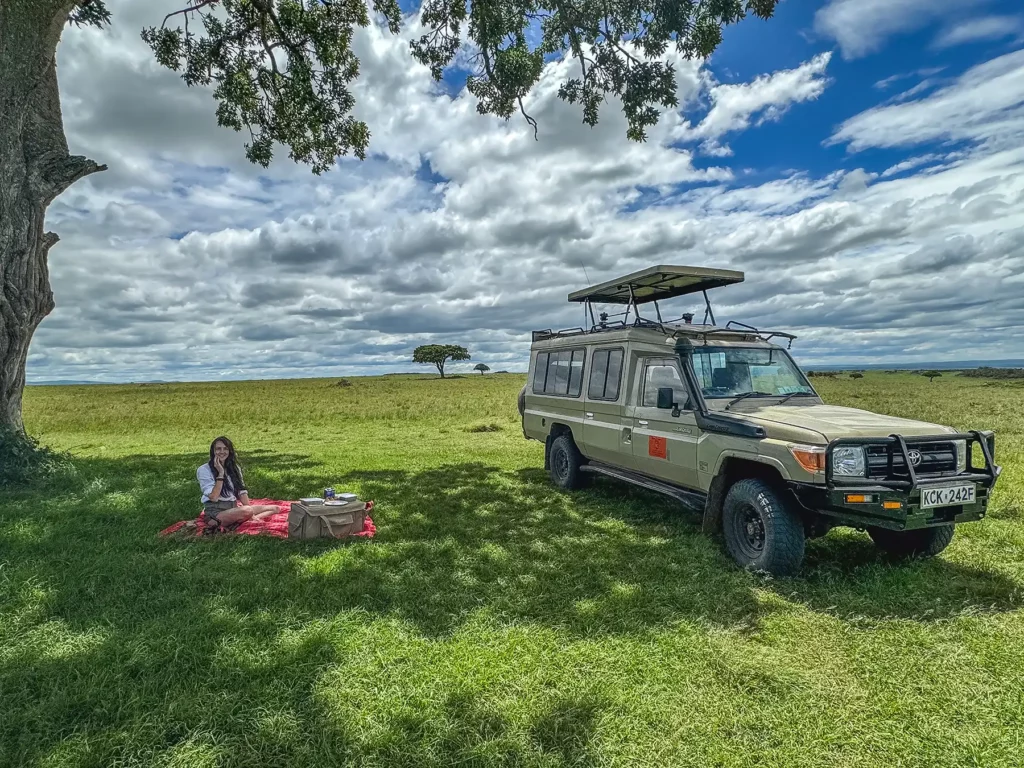
How to Book a 3 day Safari Itinerary in Tanzania?
In my opinion, the easiest way to plan a safari in Tanzania is to let a safari company take care of everything, like booking your safari and where you’ll stay. Tanzania is set up for using safari companies because planning it on your own can be tricky with more challenges compared to other places.
For example, If you start booking the accommodation yourself you have to also arrange for the driver / guide to stay at your accommodation too as distances are too great for them to go home and things quickly start to get complex. This, along with great rates is why I leave accommodation up the safari company.
In Tanzania, I like to have a local safari company plan my whole trip, which includes everything like where I stay, game drives, and other activities. But I prefer to book my own International flights to and from Tanzania.
Safari companies generally fall into the following groups:
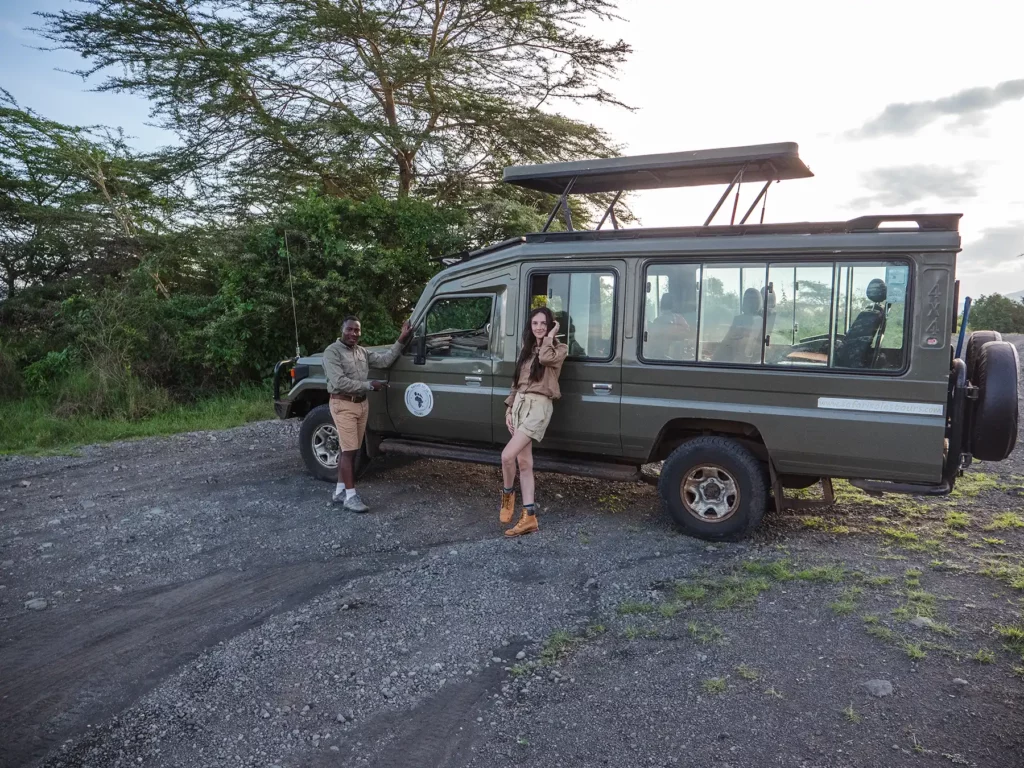
Local Tanzania Safari Companies
Local safari companies are typically run by locals and offer the best value for money.
I like to choose smaller local tour companies because it gives me a great experience, helps the local economy, and is good value for my money. They often get deals on hotels, making it affordable and less of a hassle. Plus, I get more personal service.
You can get quotes from the local tour companies I use to book my own trips on safarisbyella.com
International Travel Agents
International travel agents from your own country usually cost more, and usually, they just hire a local safari company for the safari part. Often they cover so many countries that they lack the up-to-date country specific local knowledge to give the best advice.
On the plus side, International travel agents can book international flights and offer ATOL protection (in the UK). However, I’ve always found that that my travel insurance and paying deposits with a credit card give me similar protection when I book directly.
In additional to deciding which type of tour operator to use, you also have a choice of both private and group safaris.
Private vs Group Tanzania 3 day Safaris
Private Tanzania safaris
You can request quotes for private safaris from the local tour operators I use on safarisbyella.com
Group or shared safaris in Tanzania follow a planned schedule and start at specific times. You join a tour that’s already scheduled, and you share the safari truck with others on the same tour. These safaris typically last for either 3 or 6 days.
Thinking about group safaris might be a good idea if you’re traveling alone (because private ones can be more expensive without others to share the costs) or if your budget is tight. However, keep in mind that group safaris are often designed for those on a budget. The places you stay might be simple tents with shared bathrooms, and the guides might have less experience.
The feedback I’ve had from people who’ve tried both private and shared safaris has been that their private safari experience was much better.
If you’d like to consider a group safari, you can jump to my recommended group safaris.
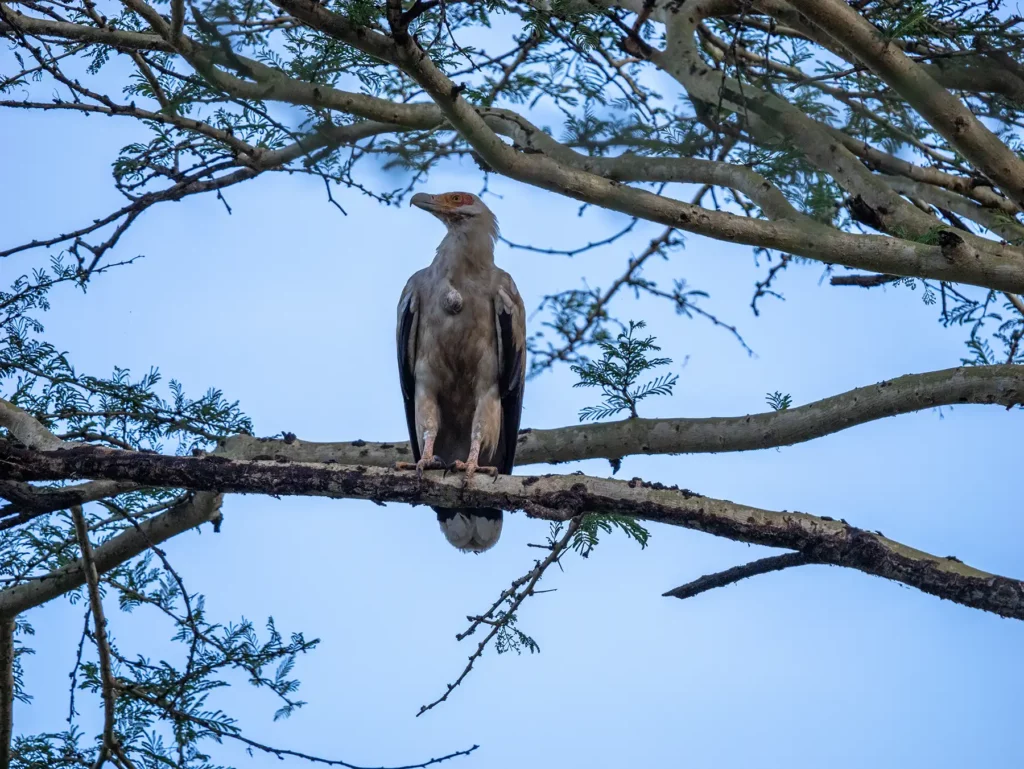
How Much Does a 3 day Tanzania Safari Itinerary Cost?
Private 3 day Tanzania Safaris start at around $300 per person per day without internal flights and $400 with internal flights. 3 Day safaris typically cost more per day than 5 and 7 day safaris because you’re going to be each day on safari compared with longer itineraries when you will usually cultural, rest or beach days which will bring down the average cost per day.
Shared / group safaris start at around $180 per person per day.
The key factors effecting the cost of your tanzania safari include:
- Your choice of accommodation has a big impact on your safari cost
- Which parks you visit with Ngorongoro Crater and Serengeti being two of the most expensive for park fees.
- Number of people in your group – for private safaris the cost the driver / guide is split between the number of people in your group so if you are traveling solo the fixed costs will be much higher compared to traveling in a group of 2 or 4. The safari trucks usually fit a maximum of 7 people.
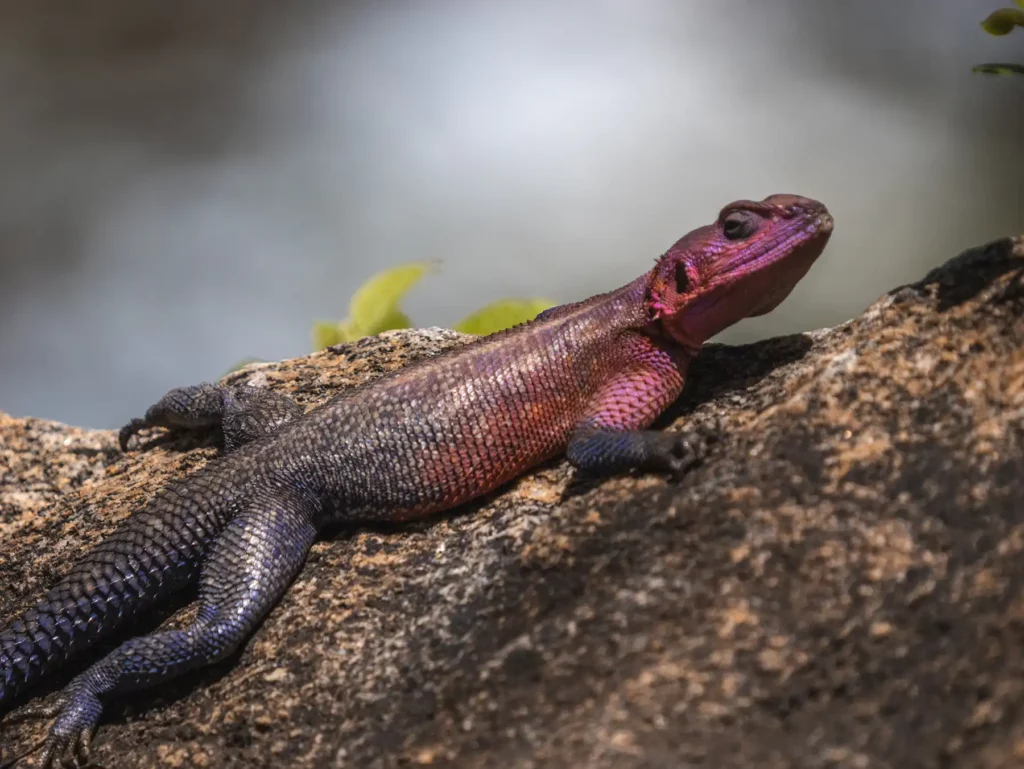
Tanzania Safari Tips & Tricks – Avoiding my Mistakes
1. If your flight gets in late, it’s a good idea to have your safari company pick you up in their safari truck or use a high-quality taxi service. In many African countries, it’s better to avoid / minimise driving at night because drivers might speed more, and it’s harder to see due to lower police presence and poor visibility. You can read about how I learn this the hard way here.
2. Pick a safari company that genuinely cares about your trip and can give you a personalised experience, not just the cheapest option. Since you’ll be spending a lot of time with the company’s driver / guide, choosing a great safari company can make the difference between having the experience of a lifetime and having a mediocre one.
3. Avoid wearing black or navy blue clothes on safari because they attract tsetse flies. If you can, wear safari colours like beige and green.
4. To spot the most animals, go on some game drives early in the morning or during the evening.
5. Put on several layers because it can be really cold at night but very hot during the day.
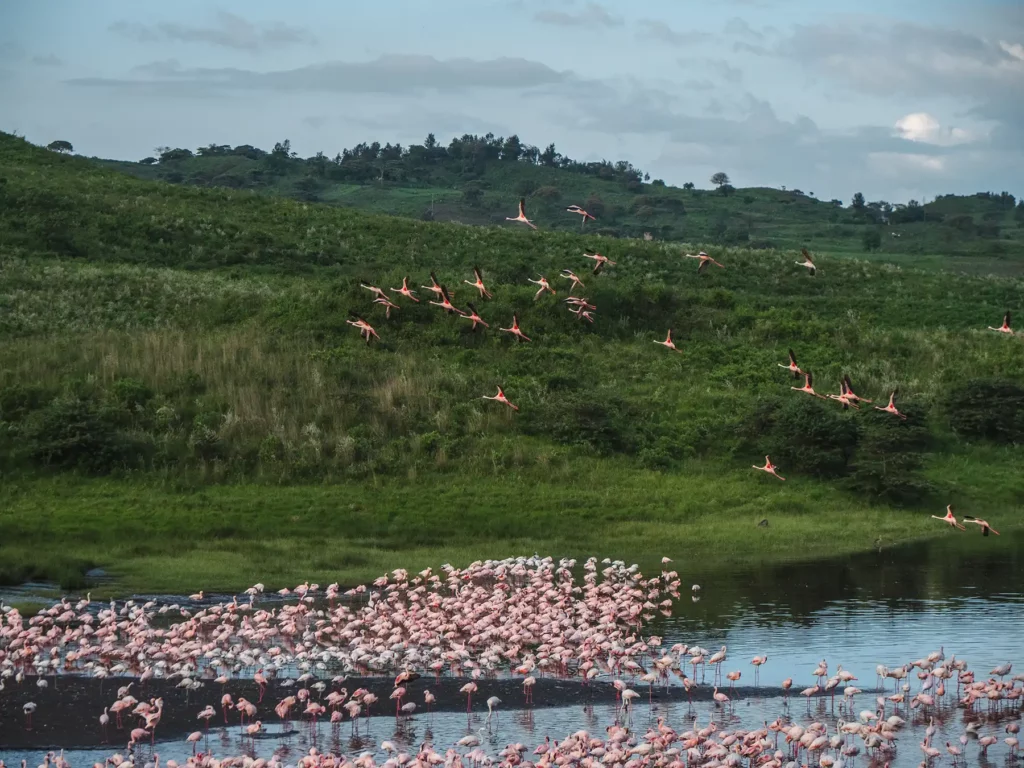
Read More Tanzania Guides
For an overview of planning your safari, you can read my Ultimate Tanzania Safari Guide.
Tanzania Itineraries
Recomended itineraries and how to book them.
7-10 Day Tanzania Safari Itinerary & Costs
5-Day Tanzania Safari Itineraries & Costs (6 unique Itineraries)
3-Day Tanzania Safari Itinerary & Costs
2-Week Tanzania & Zanzibar Safari Itinerary & Costs
3-Week Tanzania Safari Itinerary & Costs
10-Day Tanzania Honeymoon Itinerary & Costs
Tanzania and Kenya Itineraries
Multi-country itineraries and how to book them.
10-Day Kenya and Tanzania Safari Itinerary
2-Week Kenya & Tanzania Safari Itinerary
Costs & Planning
How to get the most bang for your buck and the best time of year to visit depending on what you want to do and see.
Tanzania Safari Cost – Everything You Need to Know!
The Great Wildebeest Migration Guide
Zanzibar Island – The Complete Guide
National Parks & Reserves
Complete guides to the best and most famous safari reserves, including the wildlife you’ll see, entrance costs and best time to visit.
Other Popular Safari Destinations
How to Book Your Safari
Save time and ensure an incredible safari experience by getting quotes from my recommended local safari companies.
Join the rapidly growing tribe of over 1,000 travellers who’ve booked their dream safari using my insider tips and recommendations.

